The Pre-Arranged Murder of Oswald
by John Armstrong and David Josephs
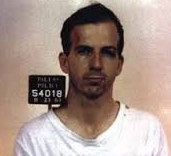 With Harvey Oswald's so-called
"defection" to Russia, his staged FPCC activities, and his
communist-loving history going all the way back to the Marine Corps, it
was easy to paint the Russian-speaking Oswald as a communist with ties
to Castro, which is exactly what happened. Oswald’s ties to the FBI,
CIA and likely to military intelligence made high-level people within
these organizations enter into a full scale cover-up.
With Harvey Oswald's so-called
"defection" to Russia, his staged FPCC activities, and his
communist-loving history going all the way back to the Marine Corps, it
was easy to paint the Russian-speaking Oswald as a communist with ties
to Castro, which is exactly what happened. Oswald’s ties to the FBI,
CIA and likely to military intelligence made high-level people within
these organizations enter into a full scale cover-up. The chosen patsy, Russian-speaking Harvey Oswald, had for years demonstrated his willingness to follow difficult orders, and following orders was critical in the days and hours before and after the assassination. Oswald, following orders, had to be in the right place at the right time for his designated role as the "patsy," unknown to him, to succeed. After President Kennedy was assassinated the conspirators knew that the "patsy" had to be eliminated. They knew Oswald would be arrested, and they knew that it would only be a matter of time before he realized that he had been set up to take the blame for the assassination of President Kennedy. Oswald, facing murder charges, would surely then explain his early life, where and how he learned to read, write, and speak Russian, as well as his connections and the names of contacts within the CIA and FBI. With this information, the search for the plotters would have been relentless. When the conspirators developed their plan to assassinate President Kennedy and blame Oswald as the "patsy," they knew their plan had to include the elimination of Oswald, which is the subject of this essay.
My interest in JFK has always focused on Oswald and, to a lesser degree, on Jack Ruby. Recently the authors of this article looked briefly at a photograph of the old Dallas City Hall at 106 S. Harwood St. in Dallas, which was built in 1914. On Sunday morning, November 24th, Oswald was to be transferred from police headquarters (City Hall building, 3rd floor) to the county jail. There were dozens of police officers in and around this building providing security for Oswald's transfer. The Warren Commission said that Ruby had entered the parking area below the City Hall building by walking down the Main St. ramp. But if Ruby's intention was to enter the building and kill Oswald, then there was no way that Ruby could be sure that he would be able to avoid dozens of police officers and enter the building by walking down the ramp. As we looked at the photo of the old City Hall our first thoughts were that it would have been nearly impossible for Ruby to have avoided the police and enter the building by walking down the ramp. The main entrance to City Hall, guarded by police officers, was on Harwood St. with two smaller entrances on Main St. and Commerce St. The only other entrance, guarded by police officers, was the ramp to the underground parking which provided access to the city jail, in the basement, from both Main and Commerce St. I could not imagine how Ruby was able to enter City Hall without being seen and stopped by police officers.
In this essay we will share our work and our thoughts with you as to when, where, and how Jack Ruby was able to gain entry into the basement of City Hall and murder Harvey Oswald. We will begin by taking a close look at the City Hall building, it’s history, it’s architecture, and in particular the points of entry into this building.
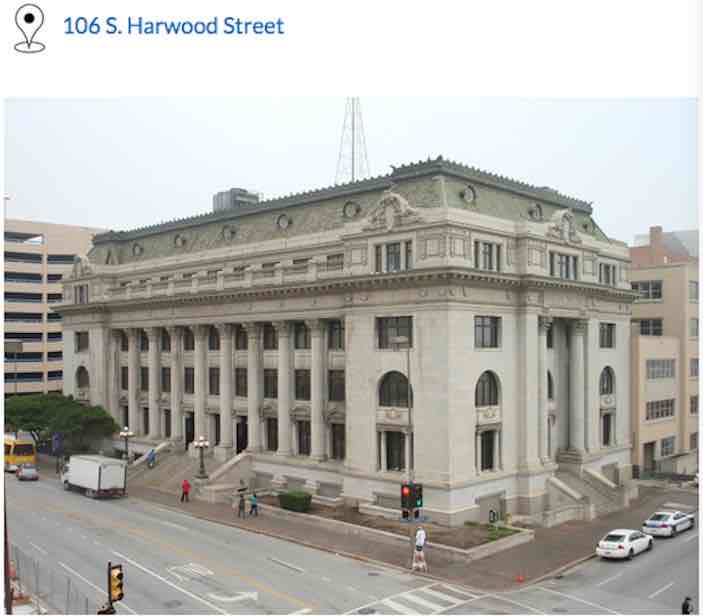
(Google)
The City Hall building, pictured above, was built in 1914 and was originally known as the Municipal Building. As can be seen from the architectural drawings below, there were five floor levels and two basement levels. The basement levels extended past the exterior walls of City Hall to both Commerce and Main Streets. The cement sidewalks on both Commerce St. and Main St. covered these basement areas. An underground ramp was built on the east side of the building and ran from Commerce St. downward to a double door entry on basement level one. The Dallas Police Department was located on the third floor of City Hall, with a small jail on the 5th floor. In the sub-basement, known as basement level two, the police department had a shooting range.
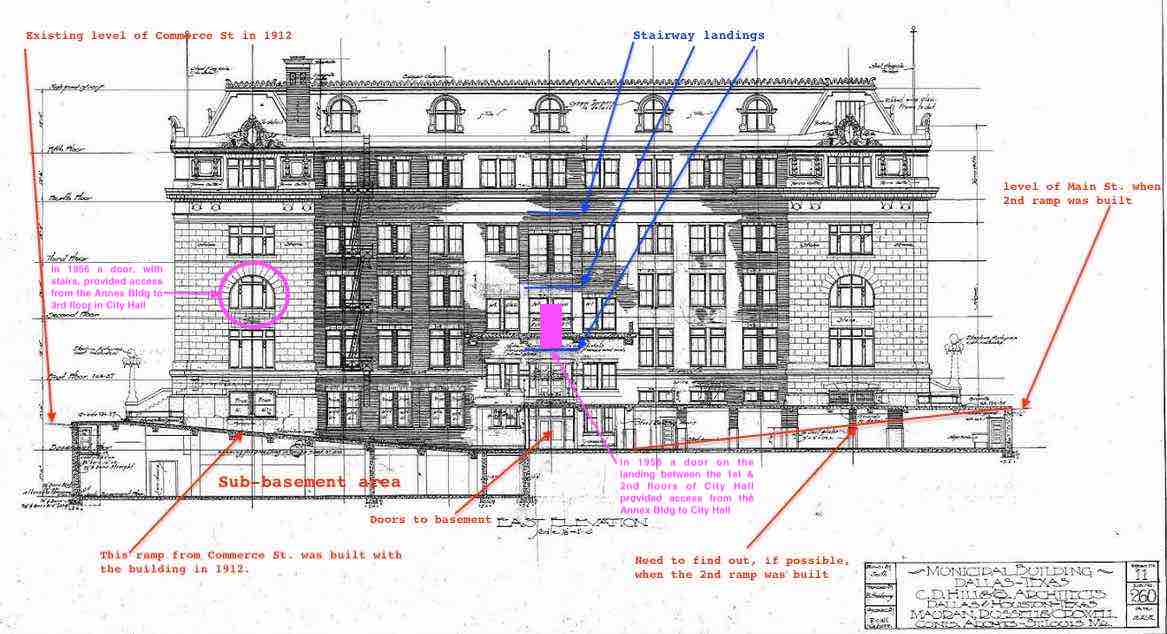
In 1956 a new building was constructed on the east side of City Hall (Municipal Building), between Main St. and Commerce St. The ramp was extended north from the double door entry to Main St. The new Annex building was joined/attached to the older City Hall building and was built over the underground ramp that now ran from Commerce to Main St. The original image below (CE 2179) was published in the Warren Volumes and shows the area where Oswald was shot. For many years researchers have looked at this image and never realized this drawing was of two different buildings. The police office, jail elevator, and small hallway were in the basement of City Hall (Municipal Building), which is shown on the left side of the ramp in the photo below. The police parking area and the ramp were in the basement of the newly constructed Annex building shown on the right side of the ramp. The image below shows the two buildings joined together—the City Hall building (1914) and the Annex building (1956), with the underground ramp between the two buildings.

This drawing/floor plan of the site of the Oswald shooting, identified as "BASEMENT" in CE 2179, was never properly identified by the Warren Commission because the image above is actually two separate buildings. To make matters even more confusing both of these buildings were known for years as the "Municipal Building." Numerous FBI, Dallas Police, WC documents, witnesses, etc. refer to the "Municipal Building," without properly identifying the building. The inscription "Municipal Building" was, in fact, placed above the entry door of each building, as can be seen in the photographs below. This has for many years caused much confusion among researchers when reading documents, police reports, FBI reports, etc., because a reference to the "Municipal Building,” without further description, could be either building.

The original Municipal Building, built in 1914, was also known as City Hall and often as Dallas Police Headquarters. In this essay we will refer to the building on Harwood St, constructed in 1914. as "City Hall." The newer building, constructed in 1956, had entries on both Commerce St. and Main St., and was originally known as the "Municipal Annex Building." We will refer to this building as the "Annex building."
City Hall, Annex building, parking lot, Western Union
The overhead view of these buildings (below) shows the location of City Hall (blue) on Harwood St., the Annex Building (red) east of City Hall, the parking lot (yellow) east of the Annex Building, and Western Union east of the parking lot. Note the underground ramp, that runs from Commerce St. to Main St. is in the basement of the Annex building. Across the street from City Hall (north) was the Allright Parking lot, where Jack Ruby parked his 1960 Oldsmobile on the morning of November 24, 1963. The Western Union office is about 300 feet east of the Main St. ramp.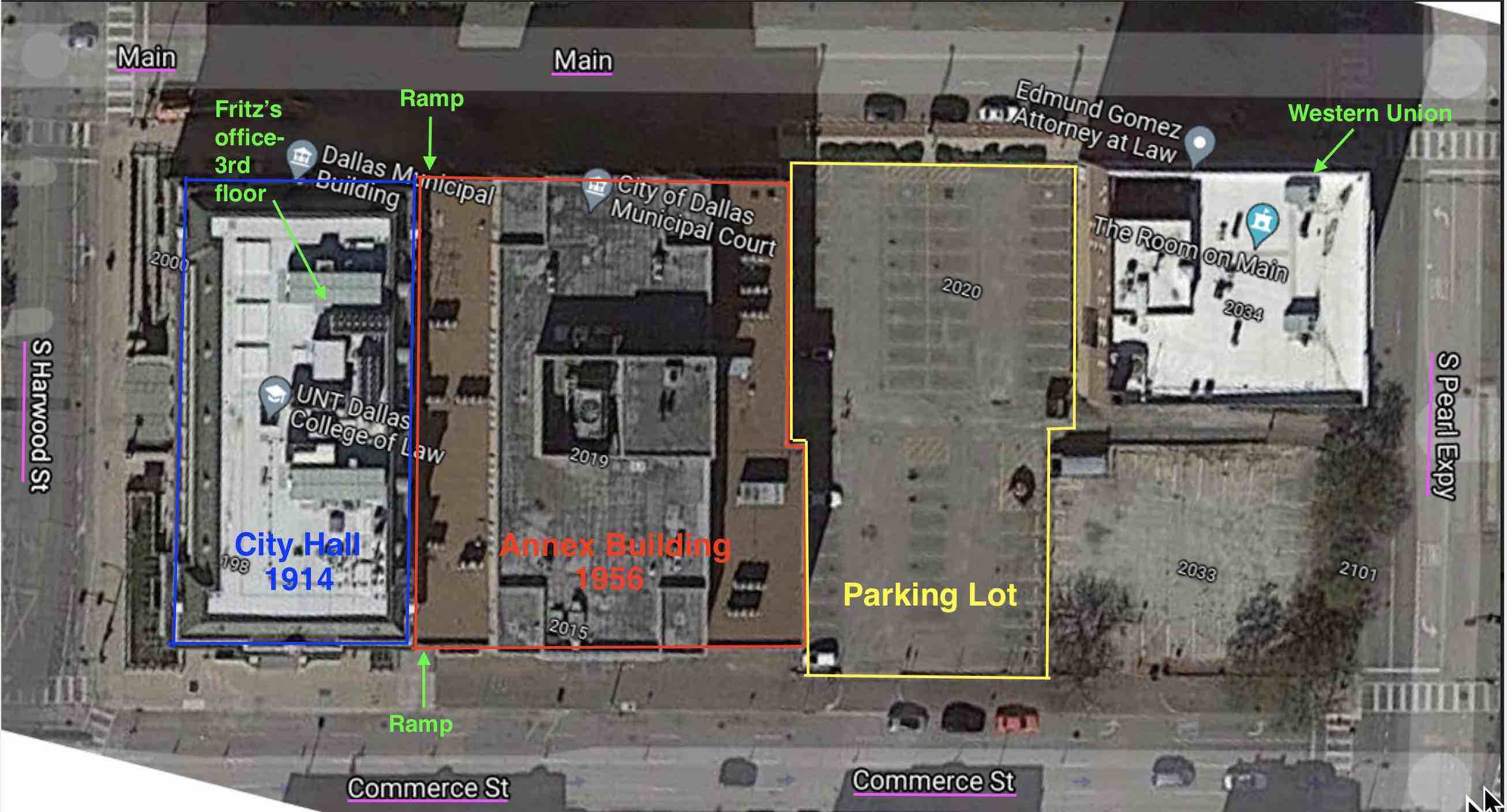
(Google)
Around 11:00 AM on November 24, 1963 Jack Ruby parked his car at Allright Parking, walked across Main Street to the Western Union office, and wired $25 to one of his dancers (Karen Carlin) who lived in Ft. Worth. Ruby then left Western Union, walked 300 feet west, and somehow got into the police parking area in basement level one of City Hall.
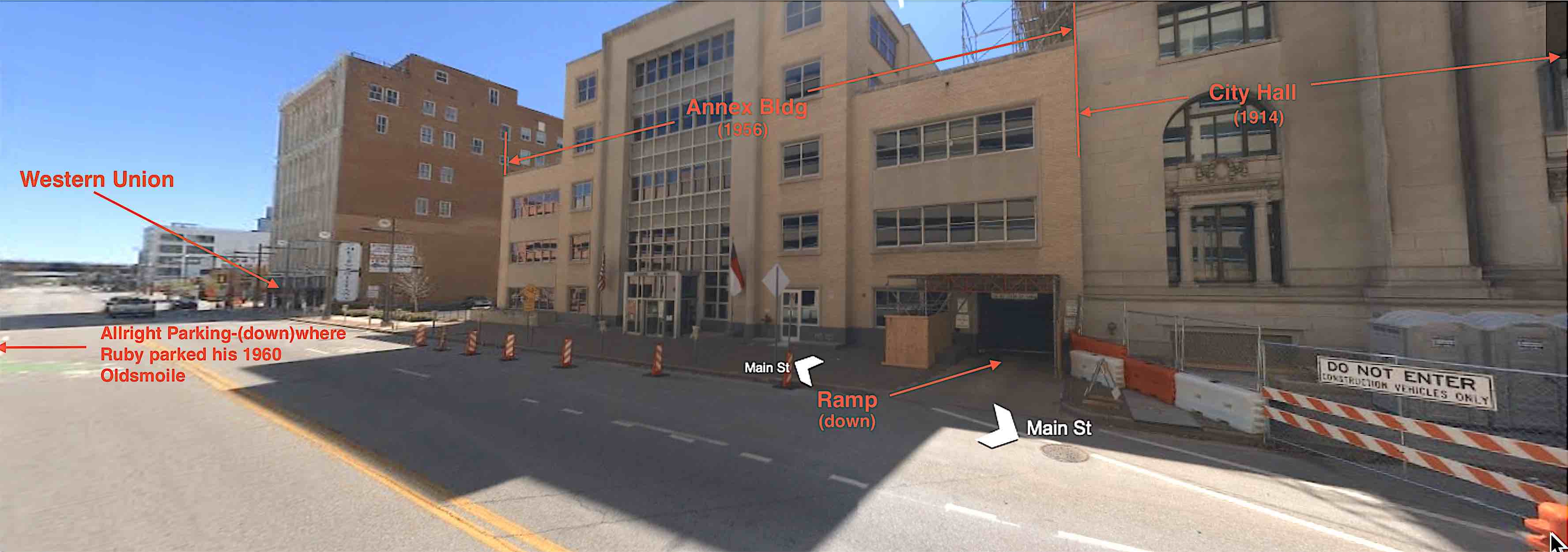
(Google)
As Ruby left Western Union, and began walking toward City Hall, Oswald was escorted from Capt. Fritz's office on the 3rd floor of City Hall to the basement. Ruby managed to get into the basement about 1 minute before Oswald arrived in the basement. The Warren Commission believed that Ruby entered the basement of the police station from the Main Street ramp (pictured above), guarded by officer Roy Vaughn. Vaughn, however, swore he did not see Ruby enter the building. Police Inspector Jack Revill interviewed Vaughn and said, “I am satisfied that Roy Vaughn did not see jack Ruby nor did he knowingly permit him to enter the basement.” Officer Napoleon Daniels agreed with Vaughn and said, “No, definitely not; there was nobody (entering the ramp).” The Warren Commission, however, concluded that Ruby did go down ramp and that his arrival in the basement was a combination of luck and coincidence. But the fact that Oswald's transfer was delayed over an hour beyond the announced time of 10:00 AM makes Ruby's arrival on cue for the shooting appear to be much more than coincidental and absurdly improbable. Ruby's whereabouts and his activities after President Kennedy was shot and killed will provide the answer as to whether Oswald’s murder was planned and premeditated or spontaneous. We will also try to show how Ruby was able to avoid dozens of Dallas Police and enter the basement of City Hall only 1-2 minutes before Oswald arrived. Ironically, it was Jack Ruby who pointed us in the right direction the day he shot Oswald. Ruby said, “... who else could have timed it so perfectly by seconds. If it were timed that way, then someone in the police department is guilty of giving the information as to when Oswald was coming down.”
November 22, 1963
Jack Ruby
Within hours of President Kennedy’s assassination Jack Ruby closed his Carousel Club and began spending a lot of time at City Hall. Defense Attorney Travis Kirk worked in the Dallas District Attorney's office for 6 years. When interviewed by the FBI Kirk said that Ruby and Fritz were close friends and that "Ruby was allowed complete run of the Police Station and particularly the Homicide and Inspector's Bureau." Kirk said that Fritz was a domineering, dictatorial officer with a photographic memory. Robert Lee Shoreman, who worked on and off as a musician at the Carousel Club, said that an older detective by the name of Fritz frequented the Carousel Club. Detectives Eberhardt and Cody were close friends of Ruby. Lt. James Gilmore was a frequent visitor to the Carousel Club and was very friendly with Ruby. Two of Ruby’s friends, Alfred Davidson and long time friend Reagan Thruman, said Ruby was casually acquainted with the Chief of Police and other high level police officers. Lt. George C. Arnett was also a very close friend of Ruby. Theodore Fleming, a DPD officer for 8 years, told the FBI there was a “good likelihood that any officer acquainted with Ruby would have allowed him into the building if Ruby had requested permission to do so.”
Captain Fritz
John William “Will” Fritz was Captain of the Homicide and Robbery Bureau, and had a reputation as a skilled interrogator, and a reputation for being able to remember minute details of investigations that occurred years earlier. His bureau was considered the elite unit of the Dallas Police Department. District attorney Henry Wade told the Warren Commission that Fritz "runs a kind of one-man operation", and was reluctant to tell others what he was doing. WC attorney Joseph Ball asked Fritz if he or other officers questioned Oswald during interrogation. Fritz answered, "I don't think those officers talked to him very much while I was out of the office. I think they might have asked him a few questions, but didn't ask him much." Capt. Fritz was clearly running a one-man operation. He was in control of interrogation, and he decided which questions would be asked and which questions would not be asked of a suspect. Fritz decided when to take notes, was always in control of his handwritten notes, and clearly in control of what information he gave to the press. Because of his experience and intimidating demeanor, most Dallas police officers respected and feared Fritz more than Dallas police chief Jesse Curry.
During the first 10 years of JFK research I kept an open mind and had not formed an opinion as to Capt. Fritz. I did not, however, understand why the man accused of killing the President of the United States was not tape recorded or why a stenographer wasn't present to record every word of Oswald’s interrogation. There was a "recording room" directly across the corridor from Fritz's office and there were several stenographers who worked at police headquarters on the 3rd floor. When WC attorney Joseph Ball asked Fritz if he had a tape recorder. Fritz answered “No, sir; I don’t have a tape recorder. We need one, if we had one at this time we could have handled these conversations far better.... I have requested one several times but so far they haven’t gotten me one.” If no tape recorder, then why was there a “recording room” across the hall from Fritz’s office? If Fritz was serious about wanting to record conversations with Oswald he could have asked any one of several dozen news reporters if he could borrow their recording device. I began to wonder if the lack of a tape recorder and lack of a stenographer during interrogations was Fritz’s idea. By not recording questions and answers from a suspect, and a reluctance to tell others what he was doing, Capt. Fritz was indeed running a one-man operation. Without a tape recorder or stenographer, there was only Fritz’s memory and his sketchy handwritten notes that recorded answers allegedly given by suspects.
A wallet at the Tippit murder scene
On the early afternoon of November 22, Dallas police were investigating the murder of Officer J.D. Tippit at 10th & Patton in Oak Cliff. Captain Westbrook, in charge of the personnel office at police headquarters, arrived at the scene at 1:37-1:38 PM driving his unmarked, dark blue, squad car. FBI Agent Bob Barrett arrived at 1:42 PM, parked his car, and walked toward Tippit's patrol car. Barrett explained, "I went on over there and Captain Westbrook was there with several of his officers.... It hadn't been very long when Westbrook looked up and saw me and called me over. He had this wallet in his hand. Now, I don't know where he found it, but he had the wallet in his hand... the wallet was there. There's no getting around that. Westbrook asked me, "Do you know who Lee Harvey Oswald is?' And, 'Do you know who Alek Hidell is?' And I said, 'No, I never heard of them.'" Westbrook then showed Barrett the wallet and the contents of the wallet. Barrett said, "I'm adamant that there was a wallet." There is no doubt that Barrett saw the 2nd wallet.... an extremely important piece of evidence that would link Oswald to Hidell and to the weapons that killed both Tippit and Kennedy. As Westbrook showed the wallet to Barrett and to fellow DPD officers, WFAA-TV Channel 8 news photographer Ron Reiland filmed the wallet. In the film clip Sgt. Bud Owens is holding the wallet while Capt. Doughty was looking at the wallet. Identification cards in this wallet identified "Lee Harvey Oswald" and "Alek James Hidell" as the prime suspects in the murder of officer Tippit. The identification cards, one for "Alek James Hidell" and one for “Alex James Hidell” with a photo of HARVEY Oswald, would link Oswald to the name “Hidell,” the name of the person who allegedly ordered the rifle from Klein's Sporting Goods that was found on the 6th floor of the Book Depository. A few minutes later, when the police dispatcher reported a suspicious person had entered the Texas Theater, Westbrook and numerous police officers hurried to the theater. HARVEY Oswald was arrested in the Texas Theater, taken out the front, placed in Westbrook’s unmarked, dark blue, squad car (circa 12:52 PM), and driven to City Hall.
Colonel Robert E. Jones, Army Intelligence, San Antonio, TX
Minutes after Oswald was arrested something very unusual happened. An unidentified person from the Dallas Police Department contacted Army Intelligence Lt. Colonel Robert E. Jones, the Operations Officer of the 112th INTC group in San Antonio. This unidentified person told Lt. Col. Jones that when Lee Harvey Oswald was arrested (1:52 PM) in Dallas he was carrying a Selective Service card bearing the name Alek James Hidell. Lt. Col. Jones then contacted the Department of Justice--the FBI--and reported the information given to him by the unidentified man in the Dallas Police Department. Later that afternoon (4:25 PM) the special agent in charge of the FBI office in San Antonio sent a memo to FBI Director Hoover and to the special agent in charge of the FBI office in Dallas, describing the information he had received from Lt. Col. Jones. Four hours after President Kennedy was assassinated, J. Edgar Hoover was advised that Oswald was also using the name “Alek James Hidell.” Fifteen years later, on April 20, 1978 Lt. Colonel Robert E. Jones told the House Select Committee on Assassinations that he got the information about ALEK JAMES HIDELL from someone inside the Dallas Police Department between 1:30 PM and 2:00 PM. A selective service card with the name “Alek James Hidell” first appeared in the wallet that Capt. Westbrook had and first showed at the Tippit murder scene around 1:40 PM. Neither FBI agent Barrett nor any of the police officers at the Tippit murder scene were known to have seen or touched the contents of this wallet. Westbrook had the wallet, he knew there was a Selective Service card in the wallet with the name Alek James Hidell, and Westbrook left the Tippit murder scene minutes later with the wallet in hand. We are convinced that Westbrook was the unidentified person who telephoned Army Intelligence Colonel Jones after Oswald was arrested at 1:52 PM.
Harvey Oswald’s wallet
While en route to police headquarters Detective Paul Bentley removed HARVEY Oswald’s wallet from his pants pocket. When Oswald arrived at headquarters (circa 2:00 PM) Bentley gave Oswald's wallet to Lt. Baker in Homicide and Robbery (circa 2:05 PM). Bentley then went to Capt. Westbrook’s office to prepare reports. Lt. Baker placed HARVEY Oswald’s wallet on the table in the interrogation room. As HARVEY Oswald sat handcuffed, in a chair, Dallas police officer C.T. Walker began inspecting the contents of Oswald’s wallet. Moments later Det. Gus Rose, and Det. Richard Stovall appeared and they too began inspecting the contents of Oswald’s wallet. A total of 12 items were found in Oswald’s wallet and listed by the FBI, with one of the items listed as 3 photographs—therefore, the total number of items found in Oswald's arrest wallet was 14 items.
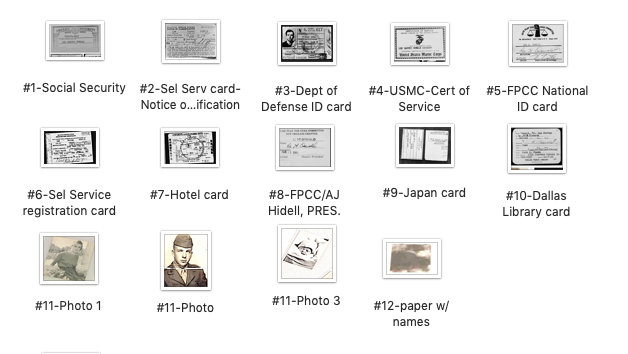
Oswald’s room on Beckley St.
Before Fritz began to question Oswald (circa 2:20 PM), "a police officer" told Fritz that Oswald had a room on Beckley. But when WC attorney Joseph Ball asked Fritz the name of this officer Fritz said he did not remember the officer’s name. How could Fritz possibly forget the name of a fellow police officer who told him that Oswald had a room on Beckley only minutes after Oswald was brought to police headquarters? Who was this officer? Why would any Dallas police officer have any reason to know or be in contact with Oswald before November 22? This officer not only knew that Oswald had a room on Beckley, this officer also had access to the Homicide and Robbery bureau which, on November 22nd, was guarded by police officers. This unidentified police officer had access to Capt. Fritz only minutes after Oswald arrived at police headquarters. It would appear the police officer who told Fritz that Oswald had a room on Beckley was a high ranking officer. Oswald was by far the most important suspect in the history of the DPD and yet Fritz did not ask his fellow police officer how he knew Oswald and how he knew that Oswald had a room on Beckley? Fritz telling the WC that he did not remember the name of this officer is, to us, withholding what we now know to be very important information. The police officer who told Fritz that Oswald had a room on Beckley was likely the same officer who drove police car #207 past Oswald’s rooming house an hour earlier, at 1:00 PM. Several years after first reading Fritz's testimony, I identified the two officers who I believe drove by 1026 N. Beckley at 1:00 PM in car #207. Those police officers were Capt. Westbrook and Sgt. Croy. I believe it was Capt. Westbrook who told Fritz that Oswald had a room on Beckley, but Fritz had a good reason for not identifying Westbrook to the WC. I was now suspicious of Capt. Fritz.
The 2nd wallet and two “Alek James Hidell” ID cards
After Westbrook returned to police headquarters he gave or perhaps shared the wallet from the Tippit murder scene (the 2nd wallet) with Capt. Fritz. We believe, with the appearance of a 2nd wallet from the Tippit murder scene, that Fritz realized and understood that Oswald was being framed for the Tippit murder. Fritz took possession of the two “Alek James Hidell” ID cards from the 2nd wallet (pictured below) but the 2nd wallet disappeared. Both ID cards have the name “Alek James Hidell” and one card, the Selective Service System card, has a photo of HARVEY Oswald. The next morning, Saturday, Fritz interrogated Oswald and ask him about these cards.
Oswald is charged with murder
Officer Gerry Hill was one of 5 police officers who took Oswald from the Texas Theater to police headquarters. After Oswald was turned over to Homicide and Robbery, Sgt. Hill went to Capt. Westbrook’s office and began preparing a report on Tippit's death. A few minutes later, when Westbrook returned to his office, he told Hill to change the homicide report to say that Oswald was the suspect in both the Tippit case and the murder of President Kennedy.
Later that afternoon (5:00 PM) Gerry Hill, a former news reporter, was interviewed by NBC TV. Hill said, “The only way we found out what his name was was to remove his billfold and check it ourself; he wouldn’t even tell us what his name was.” A reporter asked Hill, “What was the name on the billfold?” Hill replied, “Lee H. Oswald. O-S-W-A-L-D.” Hill said nothing about the name “Alek James Hidell,” because neither of the “Alek James Hidell” ID cards were in Oswald’s wallet. Hill then talked at length about Oswald's defection, his marriage to a Russian woman, and his life in the Soviet Union. When the reporter asked Hill how he knew about Oswald's activities in the Soviet Union, Hill said, “Westbrook told me!” It is obvious that on the day President Kennedy and Officer Tippit were murdered Captain Westbrook knew far too much about HARVEY Oswald. And for Westbrook, head of the personnel department at police headquarters, to drive past Oswald’s rooming house at 1:00 PM, to be at the Book Depository, to be at the Tippit murder scene, to have a 2nd Oswald wallet, and to be at the Texas Theater when Oswald was arrested, is a clear indication that he was involved as a conspirator.
Jack Ruby at police headquarters
Around 7:30 PM, with reporters, news people, and cameras filling the police station, Jack Ruby tried again to enter Capt. Fritz's office on the 3rd floor of City Hall where Oswald was being interrogated, but was stopped by two uniformed officers. How did Ruby know that Oswald was in Fritz's office? Why did Ruby attempt to enter Fritz's office? At 10:30 PM Ruby stopped at Phil's Delicatessen to purchase sandwiches and make phone calls. One of the phone calls was overheard by delicatessen employee John Frickstad. During the call Ruby said, “If anything should come up he (Ruby) could be reached at the KLIF radio station (owned by Gordon McLendon, who was a boyhood friend, classmate, and close friend of senior CIA officer David Atlee Phillips).” Ruby took the sandwiches and drove to Dallas City Hall. Later that evening District Attorney Henry Wade was giving a late night press conference (11:15 PM). Ruby was not only in the crowd of reporters, he was standing on a table with a clear view of Oswald. In fact, Tony Record said that Ruby insisted on standing on the table, even though he didn’t have a camera. When Wade said that Oswald was a member of the “Free Cuba Committee," a group populated by CIA assets and supporters such as Clare Booth Luce, Admiral Arleigh Burke, and Hal Hendrix, Jack Ruby corrected him and said, “that's 'Fair Play for Cuba Committee,' Henry.” How and why would Jack Ruby know about the Fair Play for Cuba Committee? Newsreel footage from WFAA-TV (Dallas) and NBC shows that during the press conference Ruby was impersonating a news reporter (probably KLIF radio). Some speculate that Ruby may have hoped to kill Oswald that night. Ruby, in fact, told the FBI that he had his loaded snub-nosed Colt Cobra .38 revolver in his right-hand pocket during the press conference.
November 23, 1963
Saturday morning-Fritz interrogates Oswald
By Saturday morning Capt. Westbrook and Capt. Fritz were very familiar with the two Alek James Hidell ID cards from the 2nd wallet. Police Sgt. Bud Owens was in the interrogation room when Capt. Fritz asked Oswald about these two cards. Owens was one of the police officers filmed by Ron Reiland as he and Capt. Doherty were looking at the 2nd wallet at the Tippit murder scene. Fritz showed the Selective Service ID card with Oswald's photo to HARVEY Oswald, but Oswald refused to answer any questions about the card. Secret Service Inspector Kelley wrote, "Fritz showed (Oswald) a Selective Service card that was taken out of his wallet which bore the name of Alex Hidell. Oswald refused to discuss this after being asked for an explanation, by both Capt. Fritz and by FBI agent James Bookhout." Oswald refused to discuss these cards with Fritz because it is likely that he had never seen either of these cards and realized he was being framed. Both of these ID cards came from the 2nd Oswald wallet that first appeared at the Tippit murder scene in the hands of Capt. Westbrook. The Selective Service card with the name “Alek James Hidell” contained a photo of HARVEY Oswald, and this was the one and only item that directly linked Oswald to the rifle found on the 6th floor of the TSBD. After I learned that Fritz knew about the two “Alek James Hidell” cards and the 2nd wallet, I began to wonder about his connection and the extent of his collusion with Westbrook—the first person and the last person to be seen with the 2nd wallet at 10th & Patton, the person who told Fritz that Oswald had a room on Beckley, and the person who brought the 2nd wallet to the police station. I knew that Westbrook and Croy were involved with Tippit’s murder and involved with the 2nd wallet. I was now very suspicious of Capt. Fritz and his interactions with Westbrook and Croy.NOTE: Secret Service agent Thomas J. Kelley took notes of Oswald’s interrogation, and recorded that Oswald refused to discuss the ID cards with Capt. Fritz or with FBI agent Bookhout. Capt. Fritz also took notes of Oswald’s interrogation. Fritz wrote that “O” (Oswald) told Owens the Alex James Hidell ID card belonged to him, but this was not recorded in agent Kelley’s notes. It appeared to me that this handwritten note was an attempt by Fritz, or maybe persons unknown, to link HARVEY Oswald to the rifle found in the Book Depository. This note, allegedly written by Fritz, appeared for the first time 34 years later, in 1997, when given anonymously to the Assassination Records Review Board.
By Saturday morning Capt. Fritz was well aware of the 2nd wallet, and knew this “throw down wallet” would be used to frame Harvey Oswald for the Tippit murder. I believe that Fritz knew, or at least should have known, that this “throw down” wallet was a good indication that Oswald was never at the Tippit murder scene and never shot Tippit. This is why Fritz never asked Oswald simple and very basic questions about the Tippit murder. Fritz did not ask Oswald to describe the streets he took when walking from his rooming house to 10th & Patton. Fritz never asked Oswald whether he was walking east or west on 10th St. when he first saw the police car. Fritz did not ask Oswald if he knew Tippit or why a police officer called him over to the patrol car. Fritz never asked Oswald what he and the police officer talked about thru the open passenger window. Fritz did not ask Oswald why he shot Tippit. Fritz never asked Oswald to describe the gun he used to murder Tippit. Fritz did not ask Oswald to describe the jacket he was wearing when he left the rooming house. Fritz did not ask Oswald what happened to the jacket. Fritz did not ask to describe the route and streets he took when he walked to the Texas Theater. Fritz did not ask Oswald if he bought a ticket to enter the theater. Oswald was never shown the jacket found/planted by Capt. Westbrook in the parking lot behind the Texaco station on Jefferson Blvd. Capt. Fritz dared not ask Oswald any questions about the Tippet murder because Harvey Oswald was never at the Tippit murder scene and his answer to any question about the Tippit murder would be noted by FBI and Secret Service agents sitting in the interrogation room. I now understood Capt. Fritz’s reason for not interrogating Oswald, or any suspect, with a tape recorder or a stenographer in the same room. Fritz could pick and choose the questions he wanted to ask a suspect and then write a few notes that supposedly recorded a suspect’s answers to questions. These notes, however, could never be verified, but would likely never be challenged or questioned.
A 2nd Oswald wallet from the Tippit murder scene in police headquarters was a very serious problem. If press and the public learned about a 2nd wallet they would quickly suspect this was a “throw down wallet” that conveniently appeared at the Tippit murder scene for the purpose of framing Oswald as the man who murdered Officer Tippit. When the public and/or press began to realize that Oswald was being framed for Tippit’s murder, they would also wonder if Oswald was also being framed for President Kennedy’s murder. Fritz, Westbrook, and possibly other high-ranking police personnel understood this 2nd wallet was a serious problem and had to be hidden from the public. They had to “cover-up” the 2nd wallet, hide Westbrook's involvement, hide Fritz's knowledge of the wallet and ID cards, and blame Oswald for Tippit’s murder. This 2nd wallet was not turned over to the identification bureau, no report was written, no inventory report, and no photographs were taken of this wallet. The 2nd wallet was, however, known to many DPD officers at the Tippit murder scene including Capt. Westbrook, Capt. Doughty, Sgt. Owens, Sgt. Croy, and Capt. Fritz. But when these people were interviewed by the FBI, the SS, the WC, the HSCA, or the Press not one of them said anything about a 2nd wallet found at the Tippit murder scene. Coverup of the 2nd wallet meant that every police officer who saw or handled or heard about the 2nd wallet had to be warned by senior Dallas Police officers not to say anything about this wallet. Thirty-three years later, in 1996, the public finally became aware of the 2nd wallet when the book Assignment: Oswald was written and released by retired FBI agent James Hosty. Westbrook, the man who knew the secrets of the 2nd wallet, conveniently died three weeks before Hosty’s book was released. THE 2ND WALLET IS THE CLOSEST THING WE HAVE TO A “SMOKING GUN.” Hiding the 2nd wallet from the public and the Warren Commission changed the course of history, because it kept us from learning that Harvey Oswald had been framed for the Tippit murder and framed for the murder of President Kennedy.
Jack Ruby
At 1:30 PM (Sat., Nov 23), Jack Ruby drove to the Allright Parking garage, across the street from the Annex Building, and parked his 1960 Oldsmobile. He used the phone in the office and later asked to use the telephone again at 2:00 PM. Ruby phoned the KLIF “hotline," known only to radio station personnel, and asked if any KLIF newsmen were at City Hall. After completing the call, Ruby left and within a few minutes called Thomas Brown, the manager of the parking garage. He told Brown that two men would soon stop by the garage and ask for him (Ruby). Ruby asked Brown to tell the men to contact him at KLIF radio. The two unidentified men soon arrived and Brown relayed the message. Who were these two men??
Around 3:00 PM Ruby returned to the parking garage and again telephoned KLIF radio, spoke with Garnett Hallmark and said, “I understand they are moving Oswald over to the county jail ... you know I'll be there.” At 4:00 PM a WBAP news crew was outside of the police station waiting for the transfer of Oswald to the county jail. Ruby approached a WBAP engineer and cameraman and said that he knew DA Henry Wade and offered to get information for them. Ruby was apparently trying to pose as a news reporter to once again gain access to the police station and get close to Oswald as he was being transferred to the county jail.
Dallas police officer Billy Grammer said that the day after the assassination he and his friend, Jack Ruby, had coffee together and talked for "about an hour."
Dallas Police Chief Jesse Curry discussed Oswald's transfer with the Warren Commission. Curry said, "Fritz and I discussed the possibility of getting that prisoner out of the city hall during the night hours and by another route and slipping him to the jail, but actually Fritz was not too much in favor of this and I more or less left this up to Fritz as to when and how this transfer would be made." Curry then asked Fritz, "What time do you think you will be ready tomorrow?" Fritz said that he didn't know exactly when he would transfer Oswald. Curry then said, "Do you think about 10 o'clock?" Fritz replied, "I believe so." When reporters asked Curry when Oswald would be transferred to the county jail, he told the newspaper people and the news media they were not going to transfer Oswald that night. A reporter then asked, "When should we be back, when are you going to transfer him? When should we come back?" Curry replied, "I believe if you are back here by 10 o'clock (Sunday morning) you will be back in time to observe anything you care to observe." After Ruby learned that Oswald was to be transferred to the county jail the next morning, he left the area and drove to his apartment. Ruby's roommate, George Senator, told the WC that when he arrived at Ruby's apartment at 10:30 PM Ruby was there, but he (Ruby) left 5 minutes later.
November 24, 1963
2:15 AM
At 2:15 AM (Sunday, Nov 24) Deputy McCoy, of the Dallas County Sheriff's office, received a call from a man who said that his group was going to kill Oswald during his transfer to the county jail. Fifteen minutes later (2:30 AM) an unknown individual telephoned the Dallas FBI office, spoke with Special Agent Vernon Glossup, and said, “We are going to kill the man who killed the President.” At 3:00 AM Dallas Police Officer Billy Grammer received a phone call from a familiar voice warning him that Oswald would be killed if the police didn't transfer him in secret. Grammer said the man detailed the plans of the transfer, such as a decoy vehicle, information that couldn’t be obtained without the help of police officers or other government agents. Grammer then asked a high-ranking police officer to listen in on the call. After the call ended Grammer and his supervisor prepared a sworn affidavit in which he identified Ruby as the man who called the police station and made threats against Oswald at 3:00 AM. Grammer was never asked to testify before the Warren Commission, and the sworn affidavit that he and his supervisor personally gave to Chief Curry disappeared. After placing these early morning phone calls to the Sheriff's office, the FBI office, and the Dallas Police Department Ruby likely drove home, arriving around 4:00 AM.
8:00 AM
At 8:00 AM WBAP crewman Warren Richey was on top of the TV truck with his camera and noticed a man, who he later identified as Jack Ruby, standing in front of the police building. At 9:30 AM Ray Rushing, a preacher from Plano, TX., had a brief conversation with Jack Ruby as the two men were riding in an elevator at City Hall. Warren Richey saw the same man (Ruby) again at 10:00 AM. John Smith, was inside the TV truck and saw the same man (Ruby) at 8:00 AM and again at 10:00 AM. At 10:30 AM, Ruby approached WBAP crewman Ira Walker and asked, "Has he (Oswald) been brought down yet?" The testimony and statements given by Richey, Walker, Smith, and Rushing place Ruby at City Hall between 8:00 AM and 10:30 AM.
QUESTION: If Ruby was seen by 4 people at City Hall between 8:00 AM and 10:30 AM then how could Ruby have been in his apartment at 223 South Ewing St. in Oak Cliff, across the Trinity River from downtown Dallas? At 10:19 AM one of Ruby's dancers, Karen Carlin, telephoned Ruby at his home. A long distance phone call was, in fact, recorded on Bruce Carlin's (Karen's husband) monthly phone bill (10:19 AM) from Fort Worth to Jack Ruby in Dallas. Karen Carlin allegedly asked Ruby to send her $25. But who answered the phone at Ruby's apartment?
Ruby had been sharing his apartment with 50 year old George Senator since early November. Elnora Pitts had been cleaning Ruby's apartment, every Sunday, for several weeks prior to the assassination. Every Sunday Elnora would call Ruby to make sure that he wanted her to clean that day. Sometime after 8:00 AM, on November 24, she called Ruby and a male voice answered the phone. Mrs. Pitts told the WC "he sounded so strange to me." She asked the man "who am I talking to? Is this Mr. Jack Ruby?" The man answered, "Yes, why? What do you want?" Mrs. Pitts replied, "This is Elnora." The man said, "yes, well, what--you need some money?" Mrs. Pitts replied, "No, I was coming to clean today." The man said, "coming to clean?" Mrs. Pitts replied, "This is Elnora." The man said, "what do you want?" Mrs. Pitts replied, "Do you want me to come today?" The man said, "Well, yes, you can come, but you call me." Mrs. Pitts replied, "That's what I'm doing now." Mrs. Pitts said she was scared by the way he talked. The man did not sound like Ruby, he did not recognize Mrs. Pitts, and he knew nothing about her weekly cleaning of Ruby's apartment. Mrs. Pitts said, "He didn't talk like--he never did sound like hisself." The only other person known to be in Ruby's apartment that Sunday morning was George Senator, Ruby's roommate. It is likely that Mrs. Pitts talked with George Senator at 8:00 AM, because at 8:00 AM Ruby was seen by WBAP cameraman Warren Richey at City Hall. The question of whether or not Karen Carlin talked with Ruby at 10:19 AM on Sunday morning, and asked him to send her $25, is very important. Jack Ruby's reason/alibi for being at Western Union at 11:15 AM... only minutes before he shot Oswald, was to send the $25 to Karen in Fort Worth. If Ruby did not talk with Karen on Sunday morning, then he had no valid reason for being close to City Hall, a half block from the Western Union office. Without a good reason/alibi for being close to City Hall, then he would likely be convicted of a pre-meditated and a pre-planned murder. The people who planned Oswald’s murder, wanted to make it appear as though Ruby “spontaneously” shot and killed Oswald.
Preparing for Oswald's transfer
Basement level one at City Hall, on the west side of the ramp, contained the jail office and the jail elevator from the 3rd floor. Basement level one of the Annex building, on the east side of the ramp, was the police parking area. The underground auto ramp, which divided the two buildings, ran from Main Street (north side of the building) to Commerce Street (south side of the building). Midway through the ramp there was a smaller ramp that ran slightly downward for a short distance to the L-shaped police parking garage (basement of the Annex bldg). In addition to the two ramp entrances (Main St., Commerce St.), there were five doors that provided access to the parking area from City Hall and the Annex building. Three of these doors opened into elevators (two passenger elevators; one freight elevator) near the central part of the parking area. A 4th door, at the Commerce Street side of the garage, opened into a sub basement that was connected with both City Hall and the Annex building. A 5th door, near the 3 elevators, opened onto a stairway that led to the 1st floor of the Annex building (see drawing below).
When Chief Curry arrived at police headquarters on Sunday morning he was told about a threatening phone call made against Oswald. The threatening phone call was answered at police headquarters by officer Billy Grammer, who thought he recognized the caller as his friend, Jack Ruby. Grammer asked a high-ranking supervisor to listen in on the call. Grammer then prepared a typewritten report which he and the supervisor gave personally to Chief Curry. Grammer said that Chief Curry looked at his report for about 10 seconds and then commented "there's nothing to that." (Click here for interview with Billy Grammer.) There is no evidence that Curry wrote a memo or notified a single police officer of Jack Ruby's threat against Oswald. The typewritten report that Grammer gave to Curry, witnessed by a high-ranking supervisor, disappeared. Curry, during his WC testimony, never mentioned Billy Grammer or discussed the typewritten report given to him by Grammer. Curry apparently took this threat seriously because he suggested to Assistant Police Chief Charles Batchelor and Deputy Chief Stevenson that Oswald be transported to the county jail in an armored truck, and both men agreed
At approximately 10:20 AM Curry told a press conference that Oswald would be transferred to the county jail in an armored truck. Chief Curry learned that the truck had arrived, he informed Captain Fritz that security controls were in effect and asked how long the questioning of Oswald would continue. At this point, Fritz learned for the first time of the plan to convey Oswald by armored truck and immediately expressed his disapproval. He urged the use of an unmarked police car driven by a police officer, pointing out that this would be better from the standpoint of both speed and maneuverability. Curry agreed to Fritz' plan; the armored truck would be used as a decoy. After learning about threats against Oswald, two members of the Dallas police suggested to Captain Fritz that Oswald be taken from the building thru another exit, avoiding the press, and arrive at the county jail before anyone knew Oswald had left the building. Secret Service agent Forrest Sorrels suggested to Fritz that Oswald be moved at an unannounced time when nobody was around. County Sheriff Bill Decker wanted to transfer Oswald at night. Fritz, however, was not interested in quietly removing Oswald from City Hall, transferring Oswald late at night, allowing the Sheriff's office to move Oswald, moving Oswald in an armored truck, or moving Oswald at a time unknown to the press. Fritz was focused on transferring the most important prisoner in the history of Dallas (Harvey Oswald) on a Sunday morning, in front of news reporters, cameras, and dozens of police officers. Sunday was a good day to transfer Oswald, because government employees from both City Hall and the Annex Bldg. were absent. Both buildings were essentially vacant, except for news reporters and police on the 3rd floor of City Hall (police headquarters) and in the basement.
Capt. C. E. Talbert was in charge of security for Oswald's transfer to the county jail. Talbert ordered patrolmen from several districts to report to the basement, and gave orders to remove and exclude all unauthorized persons from the basement area. Deputy Chief Stevenson instructed all detectives within the building to remain for the transfer. Shortly after 9 AM the police cleared the basement, except for police personnel. Officers Jes & Taylor were stationed at the top of the Commerce Street ramp to keep all spectators on the opposite side of Commerce Street. Officer Vaughn was stationed at the top of the Main St. Ramp. Talbert then ordered Sgt. Patrick T. Dean, along with 14 patrolmen, to search the garage, and maintenance workers were told to leave the area. Policemen searched the rafters, the tops of air conditioning ducts, closets, and the interior and trunk compartment of all automobiles parked in the garage. After the search was completed, the police allowed verified news representatives to reenter the basement area and gather along the entrance to the garage on the east side of the ramp. Later, the police permitted the newsmen to stand in front of the railing on the east side of the ramp leading to Main Street. The policemen had instructions to allow no one but identified news media representatives into the basement. Many newsmen reported that they were checked on more than one occasion while they waited in the basement. Chief Curry issued instructions to keep reporters and cameramen out of the jail office and to keep television equipment behind the railing that separated the basement ramp from the parking area. Reserve officers were stationed in various locations in and around the building. Police officers were assigned to all street intersections along the route to the county jail.
There were five doorways into the garage parking area, and a set of double doors leading to the public hallway adjacent to the jail office (photo below). A door on the Main St. side of the parking garage led to the sub-basement (door #1). Two doors opened into passenger elevators in the central part of the garage (doors 2 & 3). These two elevators were not in service, and the doors were shut and locked. Another door opened into the service elevator (door #4), which was moved to the first floor and the operator was instructed not to return this elevator to the basement. Another door, near the two passenger elevators, opened onto a stairway that led to the 1st floor of the Annex Building (door #5). Officer Alvin Brock was assigned to guard this door and the nearby elevators, with reserve officer G. E. Worley, Jr. standing nearby.

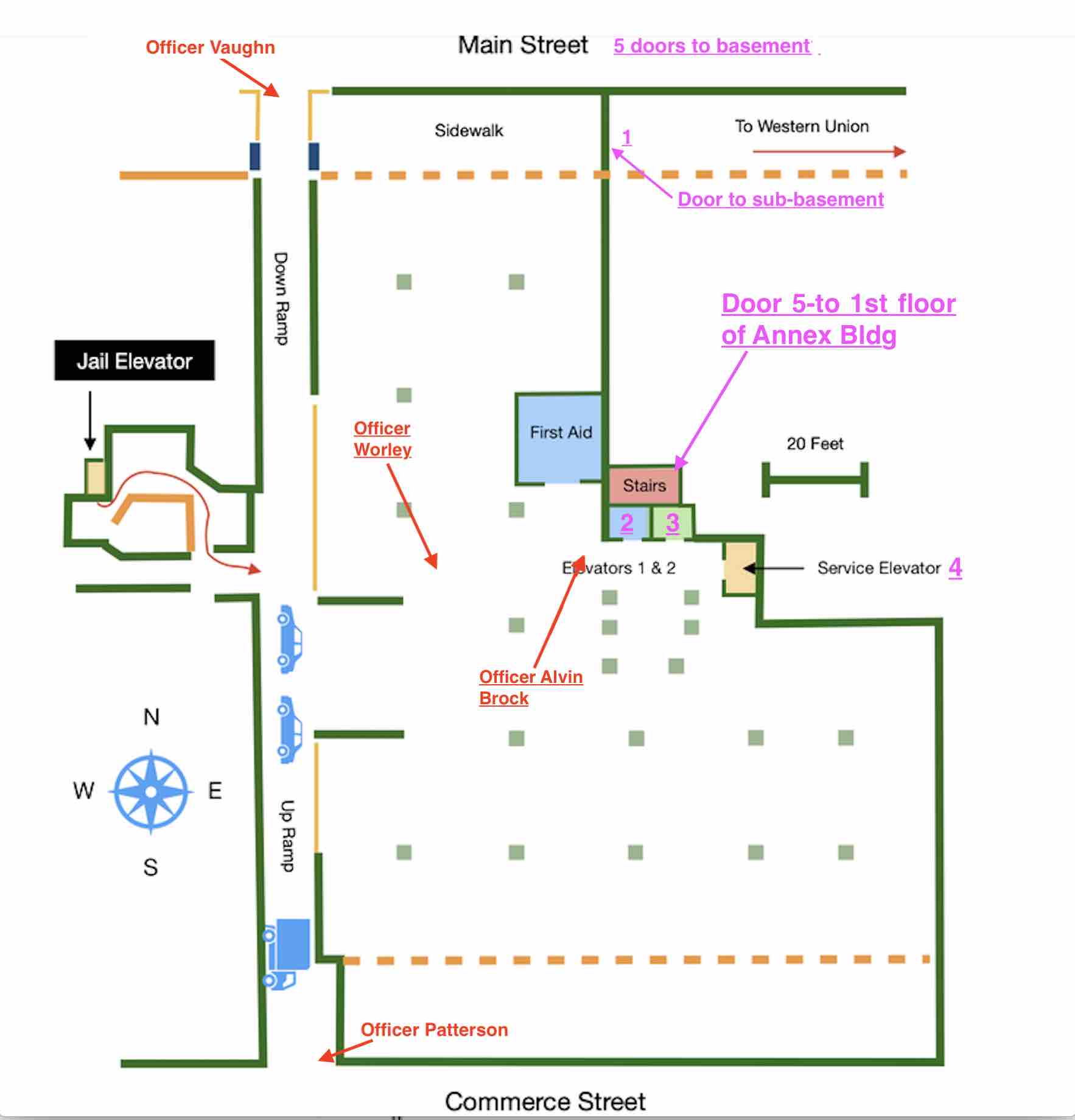
At 10:45 AM Officer Brock, who personally knew Jack Ruby, left the building and was re-assigned to traffic detail at Elm and Ervay. Brock assumed that a reservist located in the immediate vicinity (officer G.E. Worley, Jr.) would guard this area. A few minutes after Officer Brock left, Worley was also assigned to traffic duty and left the building. Fifteen to twenty minutes before Oswald was brought to the basement, there were no police officers guarding the parking area. Before Oswald was brought down to the basement, an unidentified reserve officer took Brock's place and stood guard near the elevators and the door to the stairway (see below). We believe this unidentified reserve officer was Sgt. Kenneth Croy, because minutes later Croy was standing next to Ruby when Ruby lunged forward and shot Oswald.
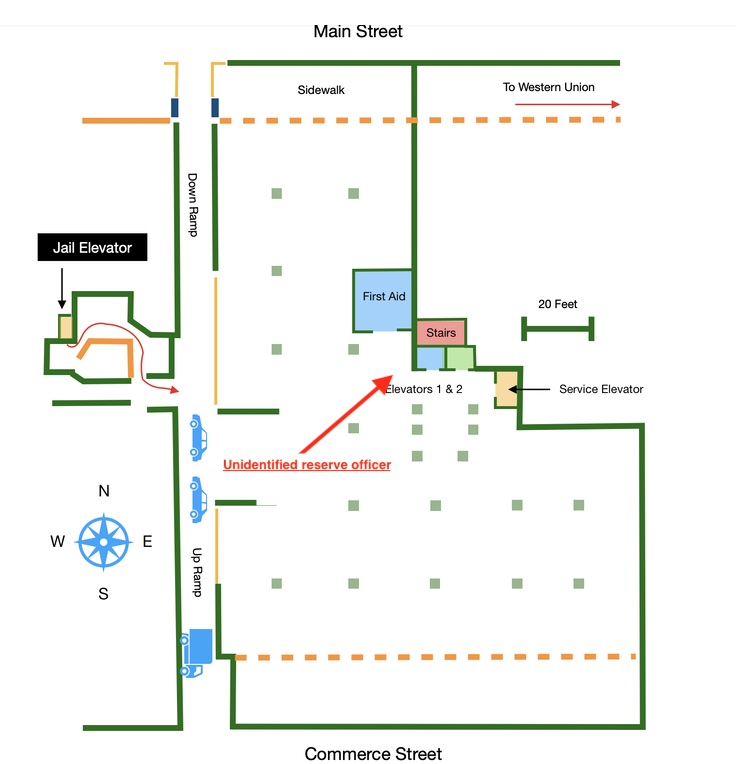
About 11 AM, Deputy Chief Stevenson requested that Capt. O. A. Jones of the forgery bureau to bring all available detectives to the basement. Jones instructed the detectives who accompanied him to the basement to line the walls on either side of the hallway that led to the ramp, in preparation for Oswald's transfer. Two police officers stood in front of the double doors that led into the hallway. Along the south wall of the hallway were eight detectives, with three detectives standing along the north wall. As the police escorted Oswald thru the hallway toward the police car they walked between the two lines of detectives.
Before Oswald appeared in the basement, 40 to 50 newsmen and 70 to 75 police officers were present. Three television cameras stood along the railing and most of the newsmen were congregated in that area and at the top of the adjacent decline leading into the parking area. A group of newsmen and police officers, about 20, stood across the bottom of the Main Street ramp. More than 100 news reporters and police were in the basement where Oswald was shot, but not one person reported seeing Ruby walk down the ramp from the Main St. entrance.
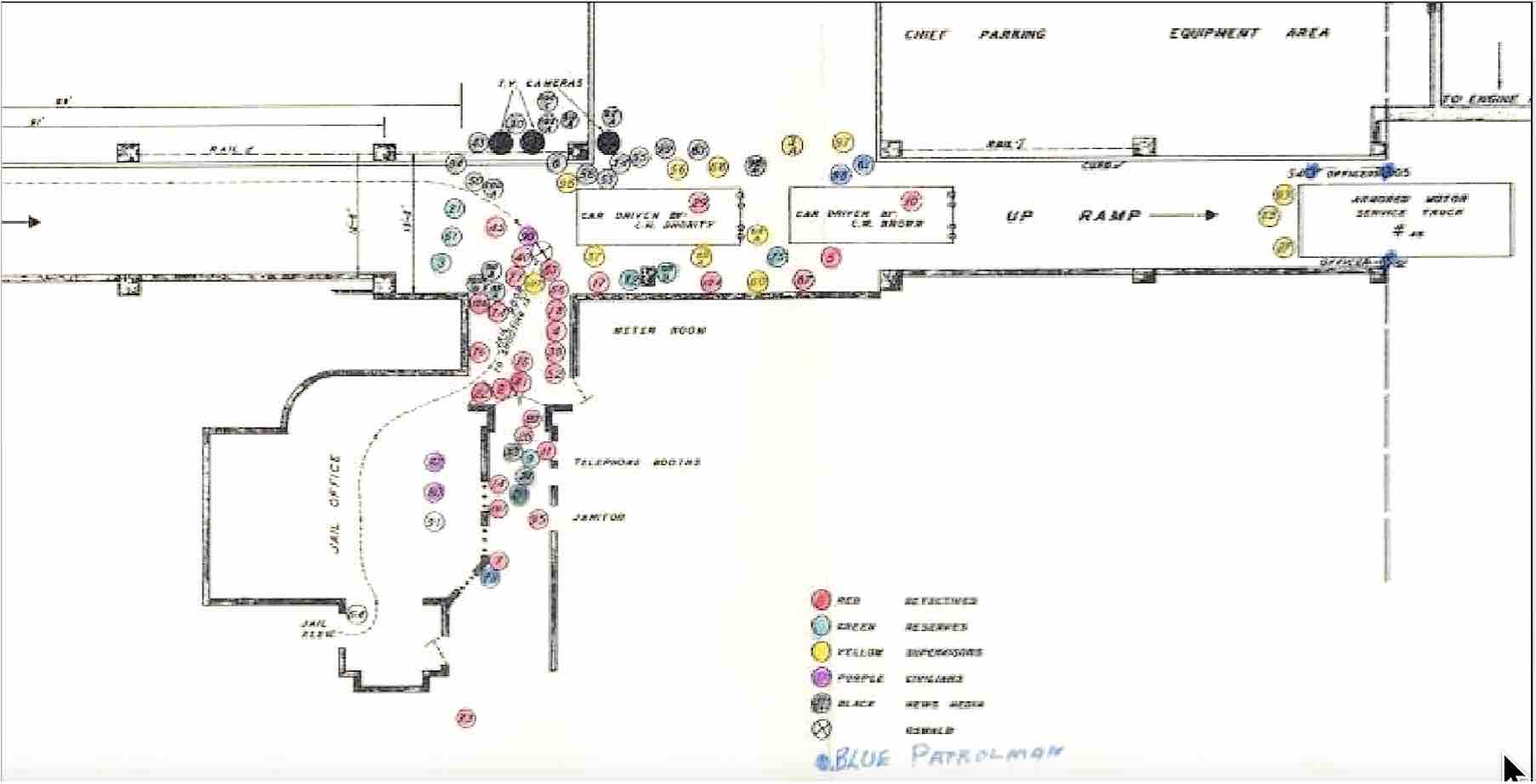
At 11:07 AM the armored truck was parked at the Commerce St. side of the ramp. When the press learned of its arrival, many of the newsmen who had been waiting on the 3rd floor descended to the basement. Chief Curry, for the first time, told Fritz that Oswald was to be transferred in an armored truck. Fritz, once again, disagreed and expressed his disapproval, citing concerns that the driver of the armored truck was not a police officer and the large truck was not very maneuverable. With the armored truck already on site, Curry then decided to use the armored truck as a decoy.
Nobody saw Ruby walking on Main St. or enter the ramp on Main St.
Sgt. Putnam assigned Officer Roy Vaughn to guard the Main St. ramp and obtain identification from anyone who wanted to use the ramp for entry into the basement. Vaughn began his assignment at 9:30 AM and stood two to three feet inside the very narrow ramp. Vaughn had known Ruby since 1959 and insisted that Ruby did not go down the Main St. ramp.
At 11:18 AM, as Ruby was leaving the Western Union office, Lt. Rio Pierce, accompanied by Sgt. James Putnam and Sgt. Billy Joe Maxey, drove an unmarked police car up the ramp and onto Main St. All of these officers knew Jack Ruby, and all said that nobody, including Ruby, came down the ramp as the car was moving up the ramp and onto Main St.
Sgt. Don Flusche was the “watch commander” and was parked across the street when he watched the unmarked police car drive onto Main St at 11:18 AM. Flusche knew Jack Ruby for years and said that Ruby did not walk down Main St., was not anywhere the ramp, and did not go down the ramp.
Harry Tasker, a cab driver, was hired by a reporter to wait outside the police building from 9:40 AM to 12:25 PM to be available to carry film of Oswald’s transfer. Tasker parked his cab across the street from the Main St. ramp and stood at the entrance to the basement 5 minutes before Oswald was shot. Tasker saw the police car drive up the ramp and leave the building but did not see anyone who resembled Ruby go down the ramp.
UPI reporter Terrance McGarry was standing on the northern portion of the Main St. ramp 5 minutes before Oswald was shot. McGarry did not see anyone resembling Ruby come down the ramp.
Detective W. J. Harrison watched the car driven by Lt. Pierce go up the ramp and said nobody came down the ramp.
Oswald's murder was pre-planned
We now know that Ruby tried to enter Capt. Fritz's office on the 3rd floor of City Hall on Friday. (How did Ruby know the location of Fritz's office on the 3rd floor of City Hall, and how did Ruby know that Oswald was in Fritz's office when he tried to enter?) Ruby was at Henry Wade's press conference on Friday evening and insisted on standing on a table, with a gun in his pocket. (How did Ruby know about a late night press conference?) Early Saturday morning and late Saturday evening Ruby was at City Hall, waiting for Oswald to be transferred. (How did Ruby know that Oswald was to be transferred on Saturday?). Ruby was looking for an opportunity to shoot Oswald and eliminate him from the moment he (Oswald) was brought to police headquarters. Oswald had to be silenced, because if there were a trial then Oswald's connections with the FBI and CIA, his so-called "defection" to the Soviet Union, his presence in the USA in 1957-58 while LEE Oswald was in Japan, his entire family history, his background, and his dual identity would be exposed.
There was, however, a slight problem..... The conspirators needed to have Oswald killed with the press watching and the cameras rolling. Oswald COULD NOT be killed in ‘police custody,’ behind closed doors, because the public would believe that Oswald was murdered in order to silence him. Sunday morning, with only the police, press, and cameras allowed in the basement of City Hall, was the perfect time and place for the public to see an enraged night club owner murder the man who killed President Kennedy. Ruby's constant presence at City Hall on Friday, Saturday, and Sunday morning clearly show that his arrival in the basement of City Hall, only one to two minutes before Oswald arrived, was not a combination of luck and coincidence as reported by the Warren Commission. Ruby was looking for an opportunity to kill Oswald, but was he acting on his own or was he following orders? Ruby answered this question on separate occasions.
1) Early morning hours on Sunday, only 8 hours before he murdered Oswald. Ruby called the Sheriff's office, the FBI, and the Dallas Police to warn them that Oswald would be killed if the police didn't transfer him in secret. Ruby was not passionate about killing Oswald, he was following orders. The purpose of Ruby’s phone calls was to provide the police with a reason to quietly and secretly transfer Oswald to the county jail, thereby making it impossible for Ruby to complete his assignment to kill Oswald during the transfer.
2) Ruby said “... who else could have timed it so perfectly by seconds. If it were timed that way, then someone in the police department is guilty of giving the information as to when Oswald was coming down.” What Ruby said was very clear: If he killed Oswald on purpose, some police officer(s) knew when to bring him down.
3) Ruby told Chief Justice Earl Warren, “Gentlemen, my life is in danger here. Not with my guilty plea of execution…. I tell you, gentlemen, my whole family is in jeopardy. My sisters, as to their lives.”
4) On June 7, 1964 Ruby told Chief Justice Earl Warren "I have been used for a purpose.”
5) A year after his conviction, in March 1965, Ruby conducted a brief televised news conference in which he stated, "Everything pertaining to what's happening has never come to the surface. The world will never know the true facts of what occurred, my motives. The people who had so much to gain, and had such an ulterior motive for putting me in the position I'm in, will never let the true facts come above board to the world." A reporter asked, "Are these people in very high positions, Jack?" Ruby said, "Yes."
Capt. John William “Will” Fritz complete lack of interest in the Tippit murder
Fritz was asked if he took notes during Oswald’s interrogation. He first told the WC, “I kept no notes at the time," but later in his testimony Fritz said that he kept only rough notes. Fritz was taking notes, as remember by other people (FBI, Secret Service) present during Oswald’s interrogation sessions. On one occasion, when Fritz asked Oswald a question that he had already answered, Oswald told Fritz to check his notes. Fritz could have questioned Oswald about many things, but the questions asked by Fritz and the answers provided by Oswald during 12 hours of interrogation, are mostly unknown. I was now able to understand and agree with Henry Wade's observation of Fritz when he said that Fritz “ran a kind of one-man operation,” and was “reluctant to tell others what he was doing.” Fritz did not ask Oswald why he boarded the Marsalis bus instead of the Beckley bus. He did not ask Oswald anything about the Tippit murder. He didn't tell the WC the name of the man who told him Oswald lived in a rooming house on Beckley. He never said a word about the 2nd wallet to anyone. He didn't let anyone tell him how to transfer Oswald. Fritz didn't let anyone tell him when to transfer Oswald. And running a kind of one-man operation meant that Fritz could pick and choose the questions he wanted to ask Oswald. He chose the information that he wanted to be made public. Maybe Fritz did receive information from Oswald that he (Fritz) dared not make public. But how are we to know? Fritz’s notes were purportedly answers to questions given to Oswald during his interrogation sessions in 1963. They may or may not be what Oswald said, and they may or may not be accurate. These handwritten notes were first seen by the public 34 years later, when they were anonymously given to the ARRB in 1997.
Capt. Fritz's handwritten notes
On Saturday morning DPD Sergeant Calvin “Bud” Owens, who was filmed while examining the 2nd Oswald wallet at 10th & Patton, was present during Oswald’s interrogation. In Fritz’s handwritten notes, which were given anonymously to the ARRB in 1997, Fritz wrote that “O” (Oswald) told Owens the Alex James Hidell card belonged to him. Secret Service agent Sorrels took notes of Oswald’s interrogation, and recorded that Oswald refused to discuss the id cards with Capt. Fritz or with FBI agent Bookout. There was nothing in the agent's notes about Oswald telling Sgt. Owens the id card belonged to him. It is difficult for me to believe that Oswald refused to discuss the id cards with Capt. Fritz and with FBI agent Bookout, yet would tell police Sgt. Owens the id card belonged to him. This specific reference to Oswald/Owens, together with other handwritten notes, appeared for the first time 34 years later when given anonymously to the ARRB. It appeared to me that Fritz's note was an attempt by Fritz, or maybe persons unknown, to link HARVEY Oswald to the rifle found in the Book Depository.
Ruby and Oswald in the basement of City Hall
Capt. Fritz's continued insistence that LHO be transferred during the day, in front of the press, on a Sunday, required dozens of police officers and detectives to work overtime on Sunday morning. But refusing to quietly transfer Oswald to the county jail, and then telling the news media when, where, and how Oswald would be transferred gave the conspirators a very convenient opportunity to plan the murder and silence Oswald.
This plan required:
1) a motive for Ruby to kill Oswald (wanted to spare Jackie Kennedy from having to testify at Oswald's trial)
2) an alibi for Ruby to be at or near City Hall when Oswald was transferred (time stamp on receipt for money transferred to Carlin from Western Union)
3) avoiding police by entering the basement from the Annex building (unseen by DPD officers)
4) arriving in the basement within 1-2 minutes of Oswald arriving in the basement (coordination: Fritz/observer)
5) blending in with the news media (dressed in suit & tie with hat)
6) knowing exactly where to stand while waiting for Oswald to appear (stood next to Sgt. Croy).
The most important part of the plan was how to get Ruby in the basement only a minute or two before Oswald was escorted from the 3rd floor to the basement. (The longer Ruby was in the basement, waiting for Oswald, the more likely he would be recognized and ordered by police to leave.) Getting Ruby into position in the basement required coordinating the movements of both Ruby and Oswald so that both men would arrive in the basement at nearly the same time. This could only be accomplished with the cooperation of Capt. Fritz, the one and only man who had total discretion as to when Oswald would be taken from his office on the 3rd floor to the basement of City Hall. Without Fritz's cooperation, Ruby would have no idea when Oswald would be brought down to the basement. However, before taking Oswald from his office and down the elevator to the basement Fritz had to be certain that Ruby was in place. This required either direct contact between Fritz and Ruby, or contact between Fritz and a 3rd person who was observing Ruby's every move. This 3rd person had to be a police officer who was well known, trusted by Fritz, and had access to police offices on the 3rd floor. This 3rd person, in my opinion, was Capt. Westbrook.
It is worth remembering that on Saturday evening Chief Curry told the press that if they wanted to witness the transfer of Oswald to the county jail, they should return to City Hall at 10:00 AM Sunday morning. But at 10:00 AM on Sunday morning Oswald was still being questioned in Fritz's office, because Ruby had not yet arrived at Western Union. Fritz had to continue questioning Oswald until he learned that Ruby was in place, in the basement of City Hall. Fritz occupied an "interior" office located on the 3rd floor of City Hall, and there were no exterior/outside windows from which to see Ruby at Western Union or see Ruby as he walked to City Hall. In fact, visual contact with the Western Union office, 1/2 block east of City Hall, was impossible from any window in the City Hall building. There were, however, windows in the northeast corner of the building on all floors that overlooked Allright Parking, where Ruby parked his 1960 Oldsmobile. On the east side of the Annex building, overlooking the parking lot, there were dozens of large windows that provided a clear view of Western Union.
There is no indication that Fritz received a phone call, placed a phone, or had any communication with Jack Ruby while Oswald was being interrogated. Yet somehow Fritz had to be alerted that Ruby was in the basement and it was time to move Oswald. A simple way to alert Fritz was thru visual contact. The only person known to have entered Fritz's office during Oswald's last interrogation was Chief Curry. Curry told the Warren Commission, "I went to Fritz' office and they were interrogating him (Oswald).... I stood around a few moments and when there was a lull in the interrogation, I asked Captain Fritz if he was about ready to transfer Oswald and he said, "Well, no; they were still talking to him," so I left the room.... as I recall, it was probably 10:30." The questioning of Oswald had to continue, because at 10:30 AM Jack Ruby had not yet arrived at Western Union. The press and news reporters filled the north end of the corridor waiting for Oswald to appear. The 3rd person (Westbrook) left his office and walked south thru the corridor, where there were few or no news reporters. He went thru the double doors, turned left, and walked east to the end of the corridor where there was a stairway hidden by a door. This location was described by Fritz in his WC testimony. This hidden stairway led from the 3rd floor of police headquarters to the 2nd floor of City Hall where a small hallway opened into the adjacent Annex building (follow the purple line). On Sunday, except for police on the 3rd floor of City Hall, there were no city employees in either City Hall or the Annex building. Westbrook could walk to the east side of the Annex building, unseen, where there were windows that overlooked the parking lot and the building where Western Union was located. Westbrook could look out any of those windows and see Ruby as he entered and then left Western Union.
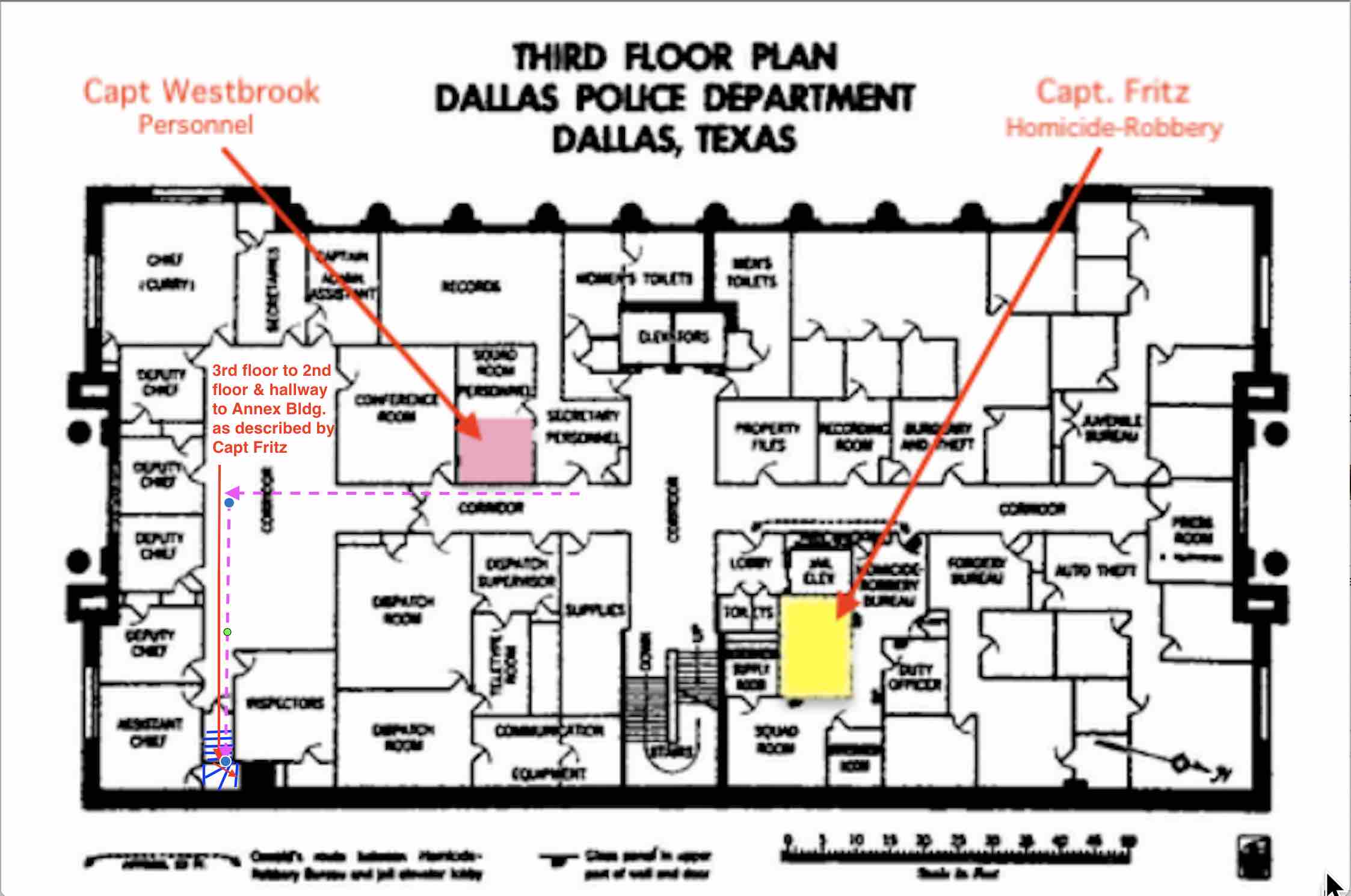
We don’t know how long Westbrook stood at the window, waiting for Ruby to arrive, but it had to be well before 11:00 AM. The best observation point from which to watch Ruby as he walked across Main St. and entered the Western Union office were the windows on the 2nd floor of the Annex building. We believe that Westbrook likely looked thru the 2nd floor window that was located directly above the entry door into the Annex building. It was essential for the 3rd person (Westbrook) to remain on the 2nd floor of the Annex building, look out a second floor window, and wait for Ruby to arrive. About 11:10 AM, Ruby parked his car at the Allright parking lot, walked south across Main St. and entered the Western Union office. A few minutes later, at 11:17 AM, Ruby sent a money order for $25 to Karen Carlin in Fort Worth.
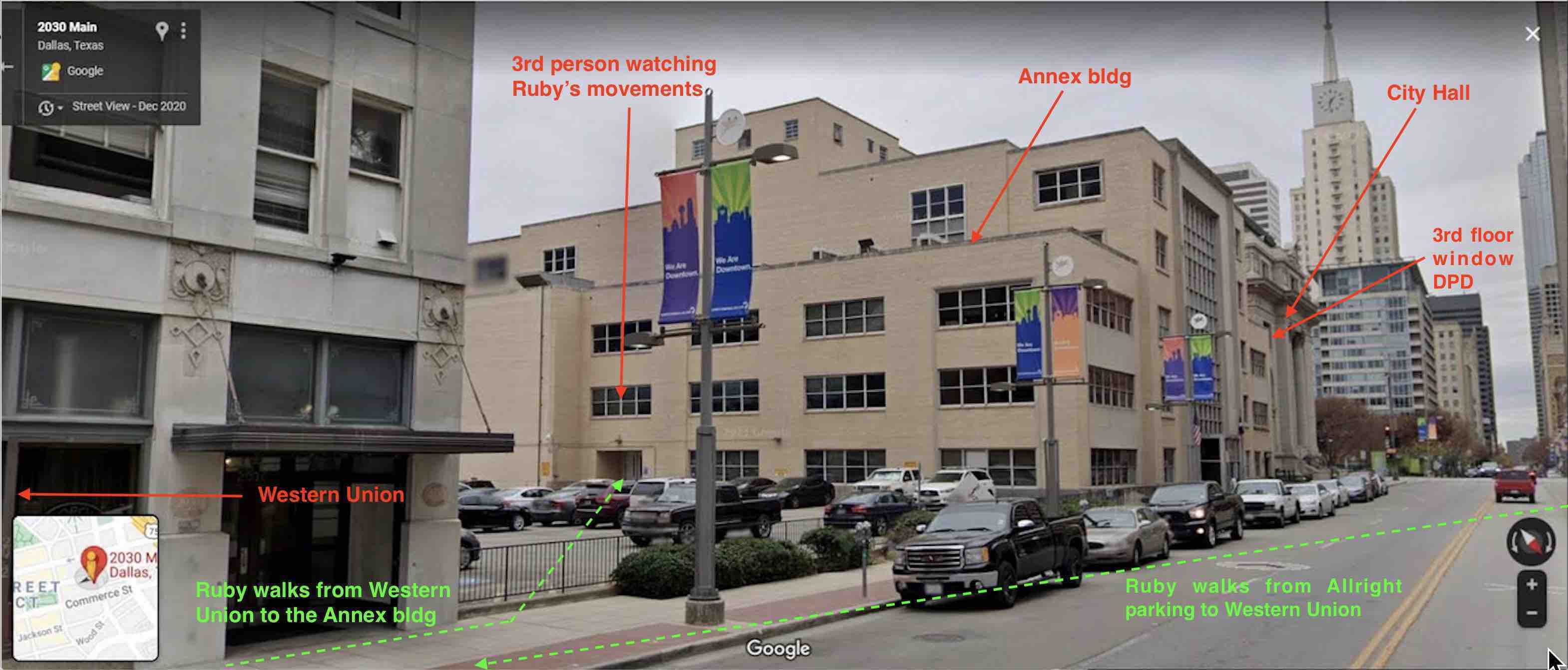
(Google)
The 3rd person (Westbrook) watched Ruby as he arrived and then left Western Union (circa 11:17-11:18 AM) and began walking thru the parking lot. Ruby entered the Annex building and walked about 40 feet to a “fire escape” stairway that led to the police parking area in the basement. Walking from Western Union to the basement in City Hall took 2 1/2 minutes (per the FBI), arriving circa 11:19 1/2 to 1:20 1/2. In the police parking area there was now only one unidentified reserve officer standing guard, who we believe was Sgt. Kenneth Croy. Why do we think this person was Croy? Because one minute later both Croy and Ruby were filmed as they stood side by side, waiting for Oswald to appear.
Capt. Westbrook, Ruby, and Capt. Fritz
In 1963 there were at least two entries from the Annex building into City Hall (as described by Fritz and Curry to the WC). One entry was for the public, and one entry was well hidden and used by the police. In 1956 the Annex building was constructed and joined with the City Hall building. The southernmost arched window on the east side of the 2nd floor of the City Hall building was made into an entry between the Annex building and City Hall. The center of the window was enlarged/heightened to accommodate a small hallway (photo below, on right). At the end of this small hallway was a stairway that led to the 3rd floor of City Hall (police headquarters). On the 3rd floor this stairway was adjacent to the assistant Chief’s office and hidden by a door at the end of the corridor (image on left).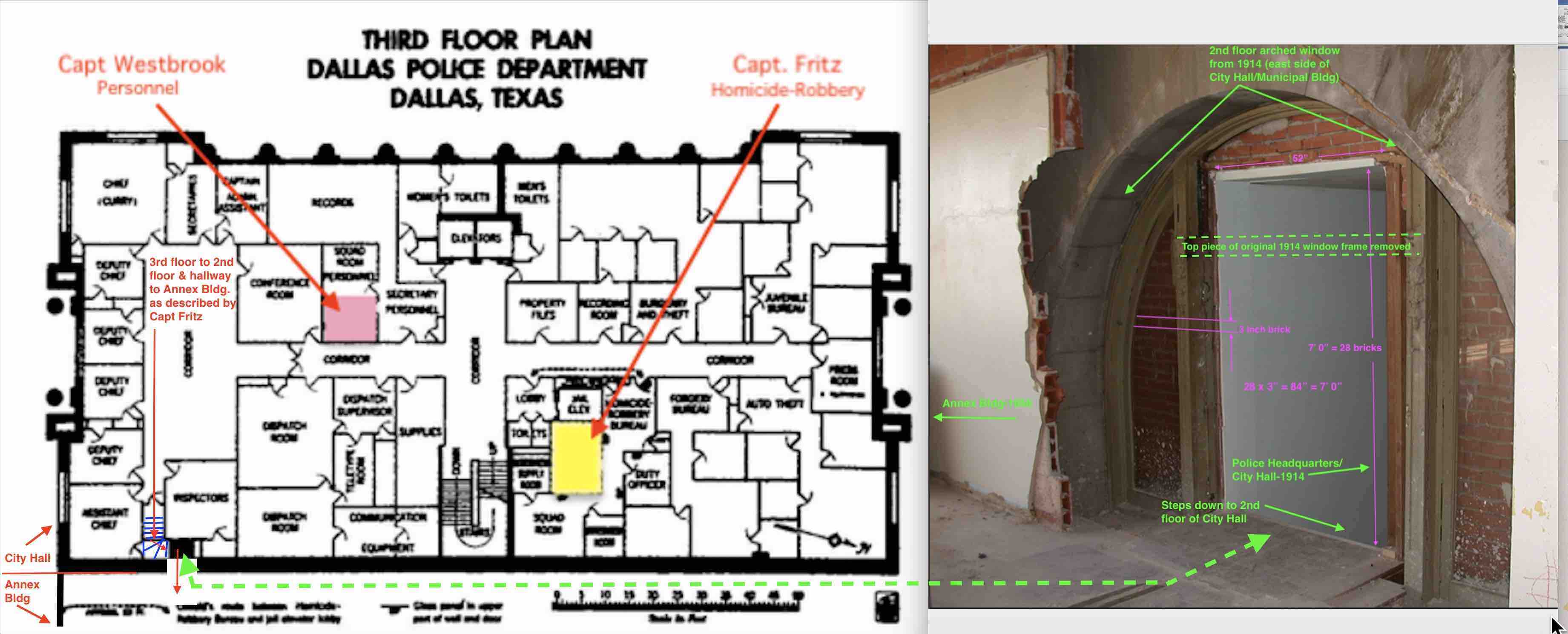
HALLWAY ON THE 3RD FLOOR OF THE ANNEX BUILDING
WITH
STAIRS TO THE 3RD FLOOR OF CITY HALL (POLICE HEADQUARTERS)
In 1963 there was another access between City Hall and the Annex building on the landing between the 1st and 2nd floors (photo below). These two points of access were described by both Capt. Fritz and Chief Curry in their WC testimony.
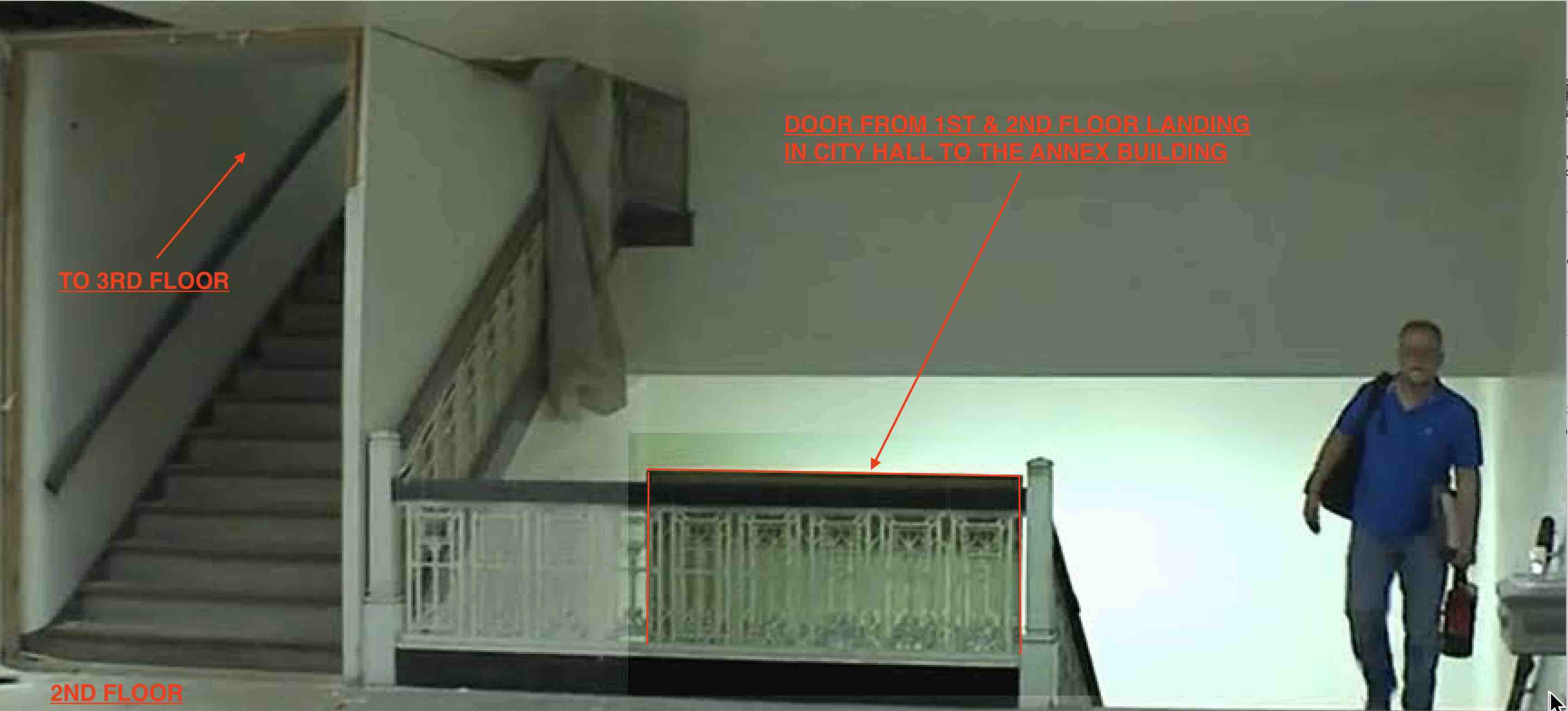
The two photos above, both showing access between City Hall and the Annex building, were taken as both City Hall and the Annex building were being renovated in 2016 at a cost of $71 million. Below is a photo of the newly remodeled 1st floor stairway and the landing where the door between City Hall and the Annex building was located in 1963 (see photo above). During renovation these two points of access between City Hall and the Annex building were eliminated (covered up). The old City Hall building is now the UNT College of Law School.
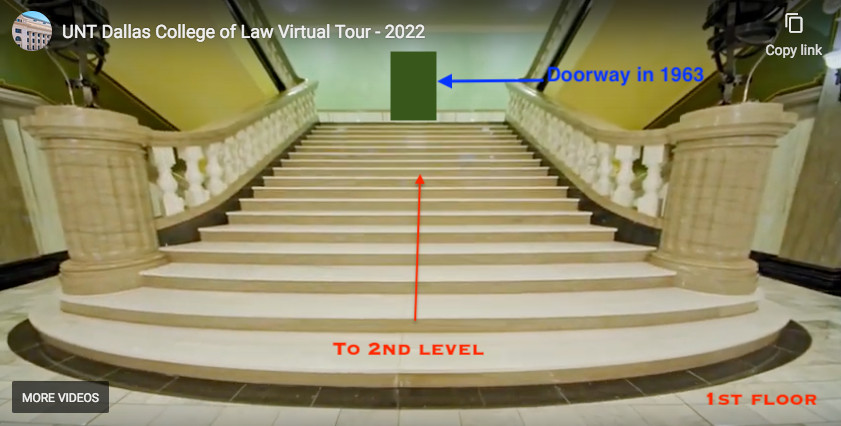
The most likely way for Westbrook to return to police headquarters on the 3rd floor of City Hall was thru the small hallway on the 2nd floor of the Annex building (see photo above). We believe that when Jack Ruby either arrived at Western Union, or left Western Union, Westbrook used the small, hidden, and inconspicuous hallway and stairs to return to the 3rd floor of City Hall. He then walked north thru the main corridor, which was crowded with news reporters, entered Homicide and Robbery (guarded by 2 uniformed officers), and went to Capt. Fritz's office. Alerting Fritz that Ruby was now in place, in the basement (circa 11:18-11:19 AM), could have been as inconspicuous as Fritz watching Westbrook walk past his office (open blinds) or Westbrook briefly opening the office door and making eye contact with Fritz.
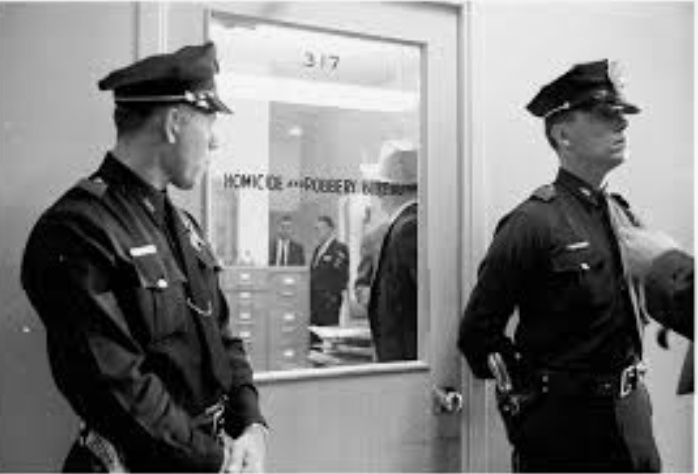
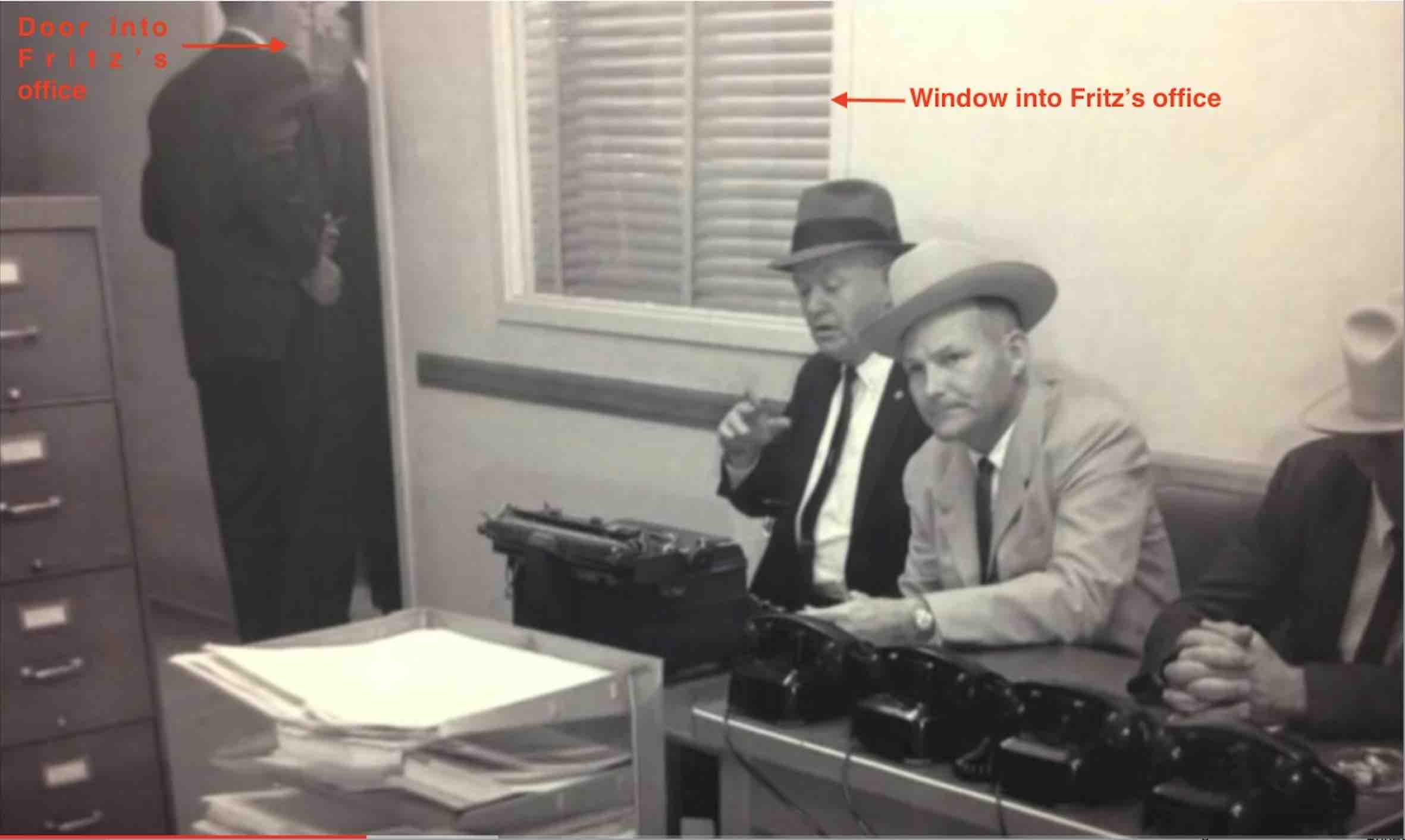
As Fritz was ending Oswald's interrogation on the 3rd floor, Ruby was already in the Annex building and walking to the stairway/fire escape from the 1st floor to the basement (circa 11:19 AM). In the police parking area both of the police officers who had been assigned to guard this area (Brock & Worley) had been reassigned to traffic duty a half hour earlier. There were dozens of press people, news reporters, and TV cameras, but only one police officer was supposed to be guarding this area—an “unidentified reserve officer” who we believe was Sgt. Croy. After walking down the stairs Ruby opened the unlocked door (a fire escape, where doors remain unlocked). As Ruby began walking thru the dimly lit parking area to the lower section of the Main St. ramp, Sgt. Croy began walking up the incline to the Main St. ramp and stood on the ramp with reporters. Croy told the WC he had only been in this position for a few minutes before the shooting.
Detective James C. Watson described the actions of the press moments before the shooting. Watson told the WC, “….they were all lined on the rail [railing in the parking area], but at the moment this starts, they crawl through and come forward [onto the Main St. ramp]…. the press was actually in the basement area, and on the fence there on the guard rail and then at the time they had already--so many of them had gotten over the rail, and were just inside on the ramp area."

The first person to see Jack Ruby on the Main St. ramp was 38 year old Jimmy Turner, a TV director at WBAP-TV in Fort Worth. Turner provided testimony that appears to provide the answer as to when Ruby was first seen on the Main St. ramp and how long Ruby was on the ramp before he lunged forward and shot Oswald, (perhaps 30 seconds before the shooting). Ruby was probably walking slowly in order to avoid coming in contact or being seen and recognized by police.
Mr. Hubert: He was coming down the Main Street ramp at that time?Turner testified that while he (Turner) was standing near the railing on the east side of the Main Street ramp (lower parking area) he first saw a man he is confident was Ruby at position “10” on line “C-D” on WC Exhibit #5080 below. Turner’s location, next to the first column and 3 television cameras, was only about 20-25 feet from where he first saw Ruby. Turner observed this man as he was walking slowly down the Main Street ramp about 10 feet from where the downward slope of the ramp ends.
Mr. Turner: That's right.
Mr. Hubert: He was moving?
Mr. Turner: He was moving at that time but this man looks like Ruby, but he seemed to be heavier than I see him now. I don't know whether it is an allusion [sic, should be illusion], being in a dark place----
Mr. Hubert: Did you see a man come out from the crowd and shoot Oswald?
Mr. Turner: Yes, sir.
Mr. Hubert: Was that man the same man that you have----
Mr. Turner: It was this same man.
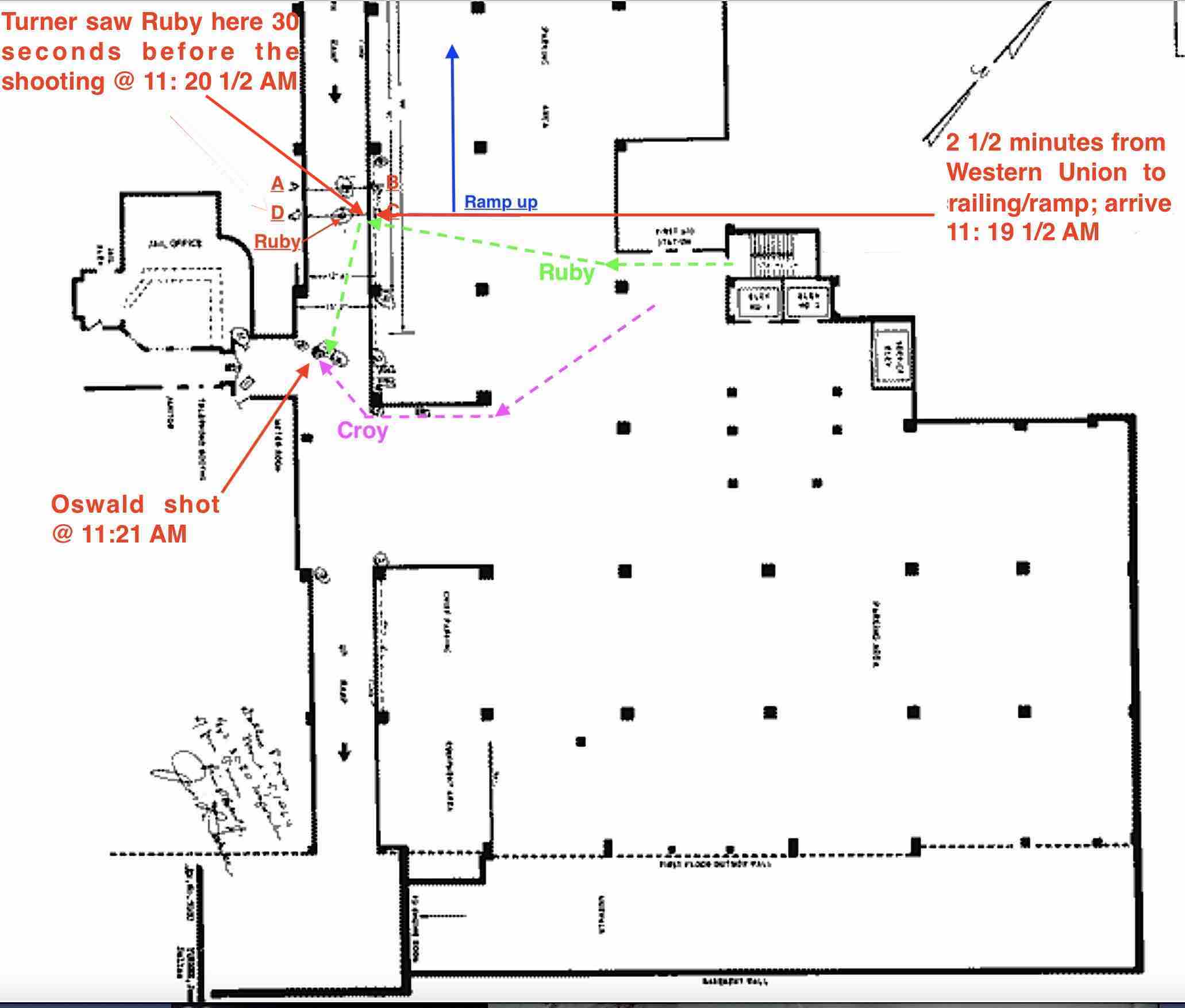
The 7 members of the Warren Commission showed no interest in investigating the possibility that Ruby entered the basement from a location other than the Main St. ramp. WC attorneys Burt Griffin and Leon Hubert were assigned to look into Oswald’s murder. They knew that from the time Ruby received the time stamp on the money order from Western Union (11:17 AM) until he shot Oswald (11:21 AM) was 4 minutes. They also knew that Jimmy Turner said that Ruby was standing on the ramp about 30 seconds before he shot Oswald. Therefore, Ruby had only 3 1/2 minutes after he left Western Union to arrive at the bottom of the Main St. ramp. The FBI was asked to determine how long it would take to walk from Western Union to the railing in the basement, where Jimmy Turner said he first saw Ruby. On June 26, 1964 an FBI agent walked from Western Union, across the parking lot, entered the Annex building, walked down the stairs to the basement, climbed thru the railing, and stepped onto the Main St. ramp in 2 minutes and 25 seconds. The image above shows the time frame and position of Ruby at 11:17 AM (time stamp on money order), his arrival on the Main St. ramp at 11:19 1/2 AM (2 minutes and 25 seconds later), and shooting Oswald 1 1/2 minutes later at 11:21 AM. The image below shows the approximate location of where Ruby climbed over or thru the railing, was seen by Jimmy Turner walking slowly on the Main St. ramp, and then standing next to Croy while waiting for Oswald to appear. It appears that Ruby could only have been in the basement, waiting to murder Oswald, for one and one-half minutes.

For Jack Ruby, he had to be on the bottom portion of the Main St. ramp, where police and detectives were waiting for Oswald to appear. The safest place for Ruby on the Main St. ramp was standing next to a friendly police officer. When Ruby heard a reporter shout “here he comes” Ruby joined a line of reporters and stood next to Sgt. Croy while waiting for Oswald to appear. Croy was the 2nd person to see Ruby on the Main St. ramp. He can be seen in film clips of the shooting and he admitted to the WC that Ruby was standing on his left side.

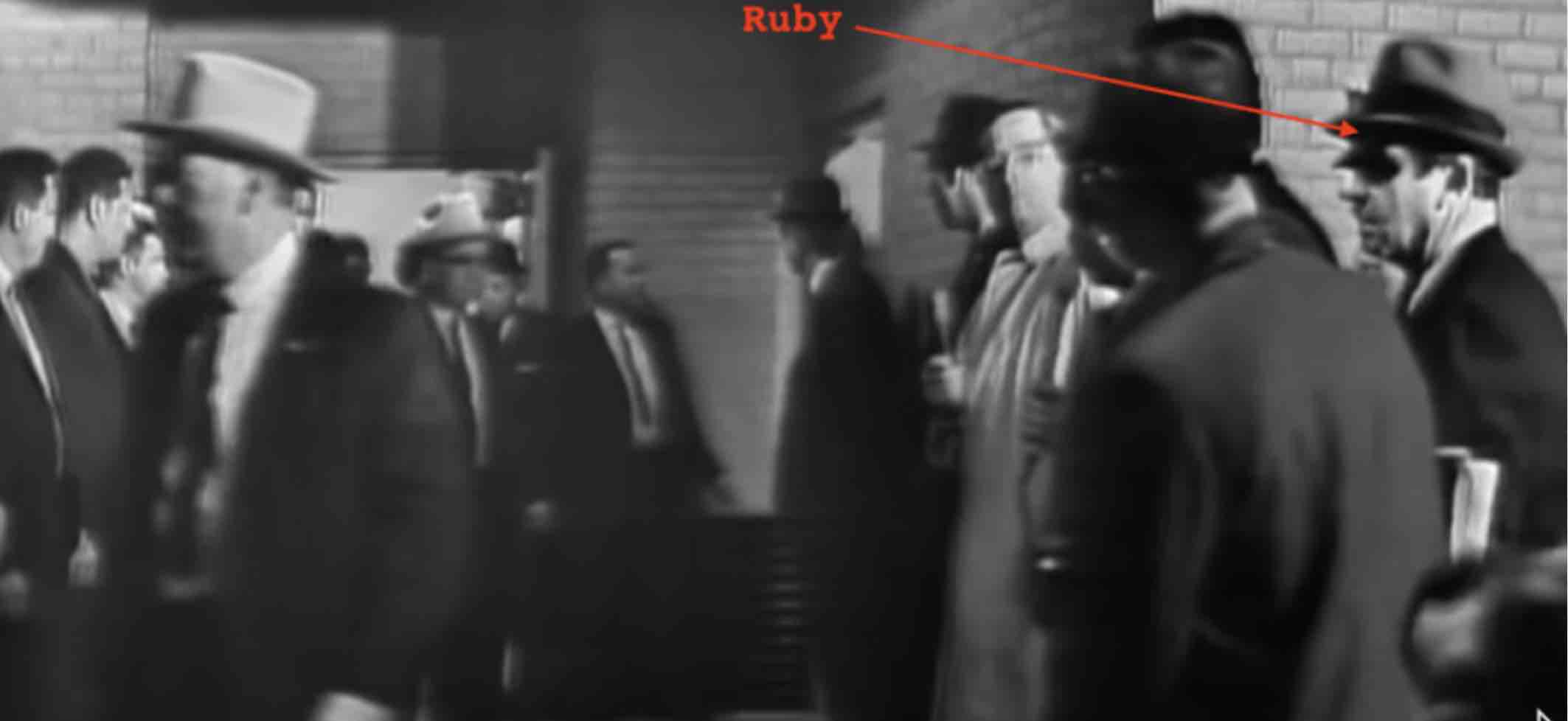
Reserve officer Sgt. Kenneth Croy
WC attorney Burt Griffin was very suspicious of Croy, because he was the one and only police officer who saw this man (Ruby) before the shooting, stood next to this man, but did not ask him for identification or order him to leave. Griffin deposed Croy on March 26, 1964, and suggested to Croy several times that he might need an attorney. Croy lied when he described Ruby and his actions immediately before he shot Oswald, and Griffin knew he was lying. Croy told Griffin that Ruby “ran by me at a pretty good clip, he was gaining momentum." He rushed/ran thru the line of reporters like a fullback. Croy saw film clips of the shooting and said, “the ones that I saw were the ones that I was trying to get the gun from Ruby.” Griffin, however, had reviewed the film clips of Ruby standing calmly next to Croy seconds before the shooting. Griffin knew that Croy did not try to stop Ruby and did not try to grab Ruby’s gun. The film clips show that when Ruby lunged forward, Croy backed up and disappeared. Griffin knew Croy was lying, and probably thought that Croy was somehow involved with Oswald’s murder. Croy was lying to deflect attention from him and make it appear as though he was doing his job and trying to stop Ruby from shooting Oswald.Unfortunately, Griffin was probably not aware that the “unidentified reserve officer” who took Officer Brock and Officer Worley’s place, near the elevators and stairs at 10:45 PM, was the same person who stood next to Ruby when he shot Oswald—Sgt. Kenneth Croy. Griffin was focused on the first and only person who said that Ruby gained access to the basement by walking down the Main St. ramp unattended—Sgt. Patrick Dean.
Sgt. Patrick Dean and the Main St. ramp
Sgt. Patrick Dean, in charge of security for Oswald’s transfer, was likely the 3rd person to see Ruby in the basement. Dean was standing near the armored truck at the top of the Commerce St. ramp (see below). From this location Dean could see down the Commerce St. ramp and the area below that included the two police cars, dozens of people, TV cameras, and the lower incline to the parking area which was dimly lit and 75 to 100 feet distant. It is important to remember that from Dean’s location he was able to see only the lower portion of the Main St. ramp, but not the upper portion and entrance into the ramp. Burt Griffin deposed Dean on March 24, 1964.

Mr. Dean: I heard someone say, "Here he comes, they are bringing him out." Of course, you could hear voices, loud voices, or excitement, and then I saw a man just dart in--this was during all the confusion, before the shooting, but I do recall seeing a man dart out. I couldn't tell who he was. It was that fast [witness snaps fingers].
Mr. Griffin: Where did he seem to dart from?
Mr. Dean: From the rail over here. The side just dart out from a group of people that were standing against the rail facing the exit [indicating].
Mr. Griffin: All right. Can you mark there with an "X" and a circle around it, approximately where he was and how close he was to this railing? Do you think he was fight on ,the railing or [indicating]--
Mr. Dean: Well, the railing--you have a curb there and then I don't recall how wide that curb is, but the railing, you can lean against standing on the ramp itself [indicating].
Mr. Griffin: Yes; how far would you say he was from that railing?
Mr. Dean: I would say he was up against the railing.
Mr. Griffin: Now, is that the man that shot Oswald?
Mr. Dean: Yes, sir.
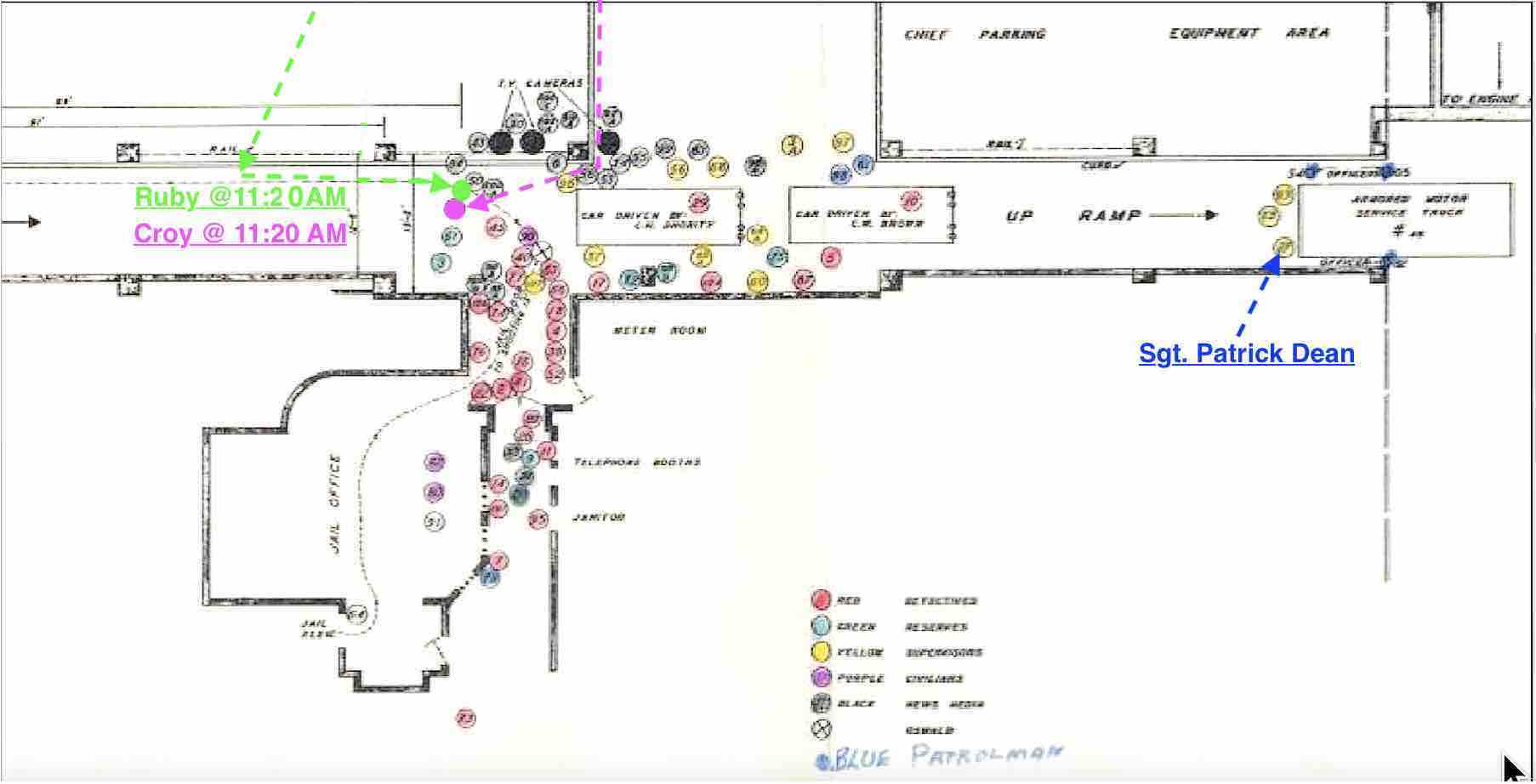
Ruby climbed thru the railing, walked slowly down the ramp, and stood side by side with Croy while waiting for Oswald to appear
There are no known witnesses who recalled seeing this man (Ruby), or anyone, walk from the stairway to the railing in the dimly lit parking area. Sgt. Dean first noticed this man when he (Ruby) “darted in” from the lower portion of the Main St. ramp and shot Oswald. It was only after this man shot Oswald and was subdued by police officers that Dean learned he was Jack Ruby, a good friend of Dean's.
Moments after Ruby shot Oswald and was subdued by police, he said, “You all know me. I’m Jack Ruby.” RUBY SAID, “YOU'RE NOT GOING TO BELIEVE THIS.” A few minutes later Sgt. Dean was interviewed on camera by the press. Five to ten minutes later Dean was on the 3rd floor of City Hall (police headquarters) and was told by Chief Curry to escort Secret Service agent Forrest Sorrels to the 5th floor (jail) to interview Jack Ruby. In his report to Chief Curry two days later, on November 26, Dean said that Ruby told him “in the presence of Mr. Sorrels that he (Ruby) had entered the basement through the ramp entering on Main Street.” Dean told the WC about their conversation. Ruby allegedly told Dean, "I walked in the Main Street ramp…I have just been to the Western Union to mail a money order to Fort Worth…. I walked from the Western Union to the ramp…. I saw Sam Pierce drive out of the basement. At that time, at the time the car drove out is when I walked in." Agent Sorrels, head of the Secret Service in Dallas, reported that Ruby “said no such thing.” Detectives Clardy, Archer, and McMillion were there with Dean when Ruby allegedly told Dean he walked down the Main St. Ramp, yet not one of these detectives said anything about the ramp in their initial reports concerning the murder of Oswald.
After the conversation between Sorrells and Ruby ended, Sgt. Dean said, “When I got back to the city hail, I contacted Lieutenant Pierce and advised him--that's when I talked to Pierce about my conversation with Ruby, and I told him that I had talked to Ruby and that he told me that--how he had gotten into the basement, which was breaking security, and that Officer R. E. Vaughn was the man involved….He (Pierce) notified the captain (Talbert) of this.” Two days later Dean submitted his written report to Chief Curry, and identified Ruby’s point of entry as the Main St. ramp (guarded by Roy Vaughn). Now Sgt. Dean could not change his story. Tom Howard was the first attorney to advise and counsel Ruby. Howard said. “Ruby’s hesitancy about discussing his entrance into the basement of City Hall was because he didn’t want to get a Dallas Police officer and friend in trouble.” But Howard said nothing about how Ruby entered the basement. During Ruby’s trial for murdering Oswald, in March, 1964, he wrote a note to his attorney, Joseph Tonahill, and said, "Joe, you should know this…. it was Tom Howard who told me to say that I had come in via the ramp.” If this is true, then Ruby did not tell Sgt. Dean, five minutes after he shot Oswald, that he used the Main St. ramp to enter the basement. Ruby then suggested to his attorney that perhaps he should stop lying and tell the truth about how he really entered the basement. The simple fact is that the first and the only person who said Ruby walked west on the Main St. and then entered and walked down the Main St. ramp was Sgt. Dean.
Later that afternoon Ruby refused to tell Capt. Fritz how he got into the basement. On November 25 Ruby refused to tell the FBI how he got into the basement. On December 1 and 3 he refused to tell DPD Lt. Revill how he got into the basement. For the next 10 days, while Sgt. Dean was spreading the word that Ruby entered the basement via the Main St. ramp, Jack Ruby was siting in jail and refused to tell anyone how he got into the basement. If Jack Ruby did not tell Dean that he came down the Main St. ramp, then Dean concocted this story, but why? One possibility is that when Dean first saw this man (Ruby) standing near the railing on the lower 1/3 of the Main St. ramp, he may have honestly assumed that Ruby had walked down the ramp from Main St. A second possibility is that Dean may have made up this story to blame Roy Vaughn for letting Ruby into the basement, thereby keeping fellow police officers from blaming him for helping his good friend (Ruby) enter the basement. A third possibility is that Dean knew that Ruby entered the basement from the stairway, with help from other police officers. Either way, Sgt. Dean was likely not telling the truth and WC attorney Burt Griffin knew that he was not telling the truth.
After reading numerous reports of Ruby visiting police headquarters on Friday, Saturday, and Sunday morning, attorney’s Burt Griffin and Leon Hubert were convinced that Ruby had been stalking Oswald. They knew that Ruby’s presence at City Hall on Sunday morning was not coincidental, and they knew that Ruby somehow entered the basement for the purpose of killing Oswald. After months of deposing witnesses and examining evidence Griffin and Hubert both believed that when Ruby left Western Union he entered the 1st floor of the Annex building thru a door on the east side of the building, walked down the stairs (fire escape), and then entered the basement parking area. When Griffin deposed Sgt. Dean on March 24, 1964 he seemed sure that Dean was lying about Ruby telling him that he entered the basement via the Main St. ramp. The overwhelming evidence was that Ruby did not enter and walk down the Main St. ramp. Griffin suspected that Ruby entered the basement parking area via the stairway adjacent to the elevators. He asked Dean for the names of the officers that Dean had assigned to guard the parking area. Dean told Griffin, “I assigned Officer R. E. Vaughn to the entrance ramp, which is entering on Main Street, Officer R. C. Nelson to the doorway coming from the police and court building and into the basement, Officer B. G. Patterson to the Commerce Street ramp, which is the exit, and I assigned one reserve officer to the southern portion of the basement, to the stairways that lead into the subbasement or the machine room. Griffin was waiting for Dean to identify the Officer assigned to watch the elevators and the stairway, but Dean was silent.
Mr. Griffin: Who checked the stairway door in the garage that leads up into the municipal building?
Mr. Dean: The stairway door?
Mr. Griffin: Yes.
Mr. Dean: I don't know of any door that leads up into the--the stairway?
Mr. Griffin: There is a stairway…. over where the elevators are
Mr. Dean: Oh, Oh, yes
Mr. Griffin: Who checked that door?
Mr. Dean: Sergeant Putnam checked it once and I checked it once and it was locked.
Mr. Griffin: Did you know at the time you checked it that even though the door was locked from the outside, it could be opened from the inside?
Mr. Dean: [No response.]
Mr. Griffin: Now, where did you station Brock?
Mr. Dean: Put him in a position that he could see this door here and also these three elevators [indicating].
At 10:45 AM Officer Brock was removed and assigned to traffic detail by Sgt Putnam and/or Sgt. Dean. A few minutes later Officer Worley was removed from his post near the incline that lead to the ramp. Both men were assigned to traffic detail. There was now only one “unidentified “ reserve officer in the basement parking area near the door to the stairway (fire escape), but Sgt. Dean did not provide any of this information to Griffin.
Burt Griffin now had several good reason to doubt that Ruby told Dean he came down the ramp, because the overwhelming evidence was that Ruby did not enter and walk down the Main St. ramp. While questioning Dean on March 24, 1964, Griffin abruptly stopped and told the stenographer to take a break. Griffin confronted Dean, said that he didn’t believe him, and asked him to reconsider his testimony. Griffin expressed his doubts about what he felt were untrue answers given by Dean and suggested Dean may need an attorney. Griffin wrote a memo to J. L. Rankin, the WC chief counsel, explaining “I believe it likely Ruby came in by another entrance to a point where Dean could have stopped him and that Dean... is trying to conceal his dereliction of duty”. On May 15, 1964 both Griffin and Leon Hubert sent a memo to J. Lee Rankin with a list of areas that needed further investigation and a list of people they wanted to question.
Sgt. Dean complained about Griffin’s accusation to D.A. Wade, who then called President Lyndon Johnson at his ranch in Texas, and told him about the Dean/Griffin confrontation. Seth Kantor acknowledged that President Johnson began to exert pressure on Earl Warren. Dallas Morning News reporter Earl Golz interviewed Dean concerning his dispute with Burt Griffin. Dean said, “”Henry Wade (Dallas District Attorney) called President Lyndon Johnson at his ranch and told him about this trouble I was having with Griffin. The next day it was on the front page about Griffin loading his butt on the airplane and going back to Washington.” Texas attorney general Waggoner Carr accompanied Dean to Washington DC when he met and shared his complaints with Earl Warren about Griffin’s behavior. Griffin was not allowed to confront Dean at the Warren-Dean meeting. The WC soon recalled Griffin from Dallas and the investigation of the Dallas Police stopped. Griffin had this to say: “I always thought all along about the Dallas police that anything that would get them into trouble or embarrass them, THEY WOULD LIE TO US ABOUT. NO question about it.”
NOTE: In March, 1964, Jack Ruby was found guilty of the premeditated murder of Oswald, but his conviction was overturned by a Texas Appellate Court. The Court found that Dean’s testimony should not have been admitted during the trial.
Roy Vaughn
Roy Vaughn, the officer assigned to guard the Main St. ramp, talked with Lt. Pierce three hours after Ruby shot Oswald. Vaughn was told that Ruby allegedly told Sgt. Dean that he entered the basement via the Main St. ramp. Vaughn, who had only two brief contacts with Ruby years earlier, insisted that Ruby never came down the ramp. Vaughn began his assignment at 9:30 AM and stood two to three feet inside the building and in the center of this narrow ramp (Main St.). Harry Tasker, a cab driver, was standing at the Main St. entrance entrance to the basement 5 minutes before Oswald was shot, but never saw anyone who resembled Ruby go down the ramp. UPI reporter Terrance McGarry was standing at the Main St. ramp 5 minutes before Oswald was shot, but didn’t see anyone resembling Ruby go down the ramp. At 11:18 AM, as Ruby was leaving the Western Union office, Lt. Rio Pierce, accompanied by Sgt. James Putnam and Sgt. Billy Joe Maxey drove an unmarked police car up the ramp and onto Main St. All of these officers knew Jack Ruby, and all said that nobody, including Ruby, came down the ramp as the car was moving up the ramp and onto Main St. Watch commander Sgt. Don Flusche was parked across the street and watched the unmarked police car drive onto Main St at 11:18 AM. Flusche knew Jack Ruby for years and said that Ruby did not walk down Main St., was not anywhere near the ramp, and did not go down the ramp. Detective W. J. Harrison watched the car driven by Lt. Pierce go up the ramp and said nobody came down the ramp.Roy Vaughn realized, but could not understand, why Sgt. Dean was trying to make it appear as though he failed to properly guard the Main St. ramp. He knew that Ruby did not come down the Main St. ramp, but Dallas police officials were glad to hear that Ruby came down the ramp and that no Dallas Police Officers helped Ruby enter the basement. Vaughn was fighting a losing battle and with the majority of police officers believing that he came down the ramp, Vaughn was hopelessly outnumbered. Vaughn sought the assistance and counsel of a local attorney, James Niell, who suggested that Vaughn begin legal proceedings to try and clear his name. Vaughn was told by police Chief Byrd to make an appointment and visit with City Attorney Alex Bickley. During their brief meeting, Bickley asked Vaughn not to go to court because “the truth might come out about how Ruby got into the basement.” And the truth would likely show Ruby’s involvement with Dallas Police officers.